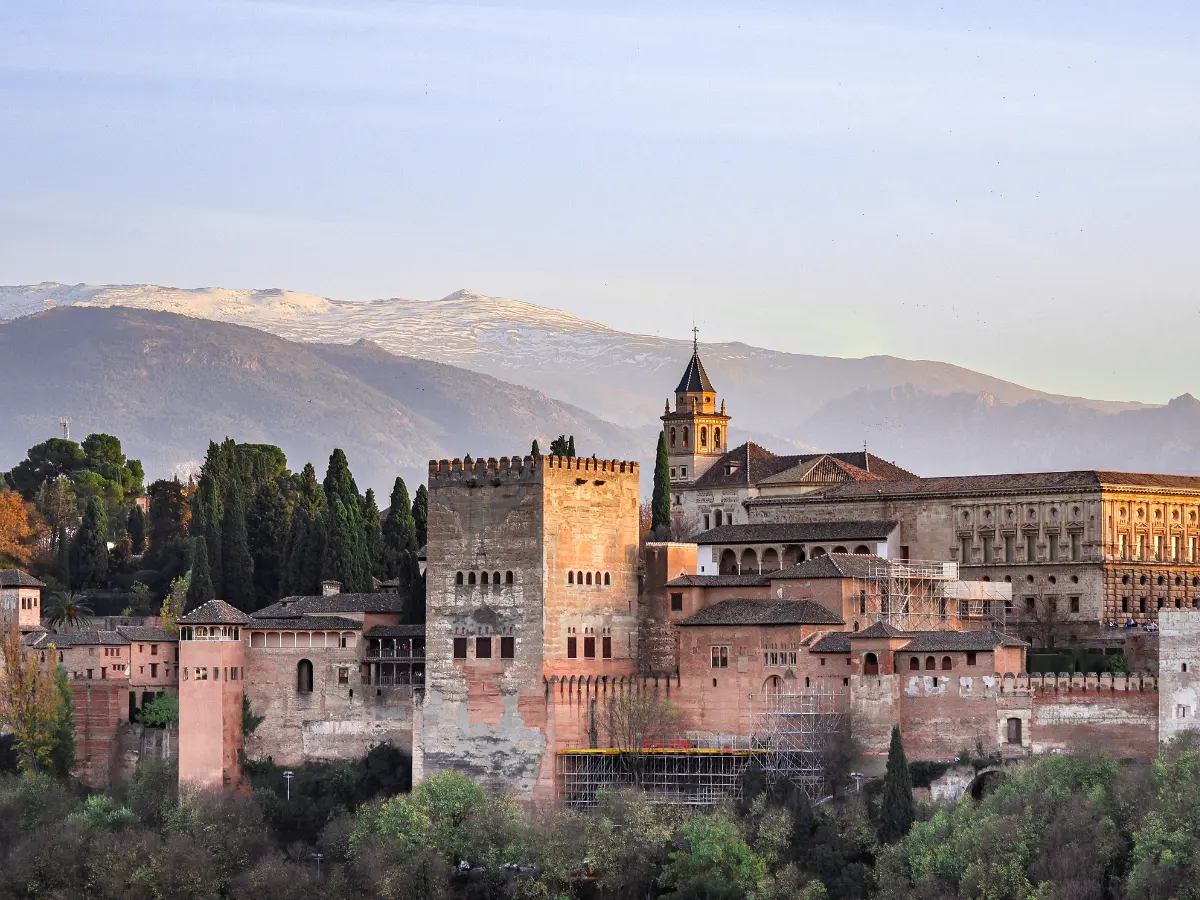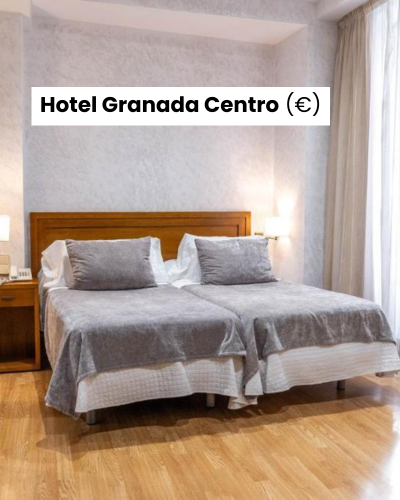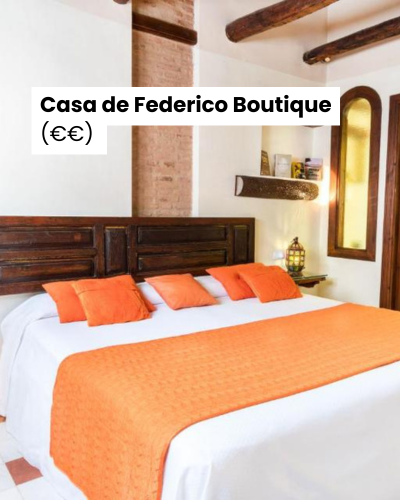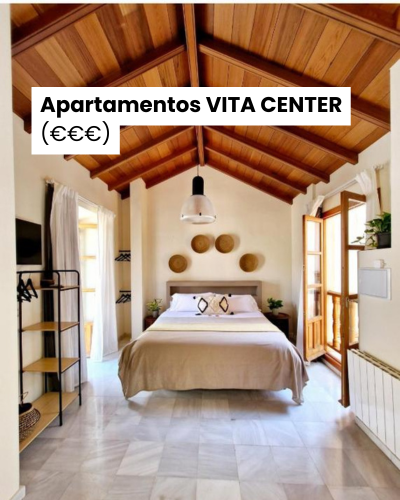Granada may not be as famous as Seville or Córdoba, but it’s a city that’s absolutely worth exploring. Spending 2 days in Granada gives you just enough time to explore its rich history, stunning architecture, and lively culture. At the heart of it all is the Alhambra, an absolute must-see and one of Spain’s most iconic landmarks.
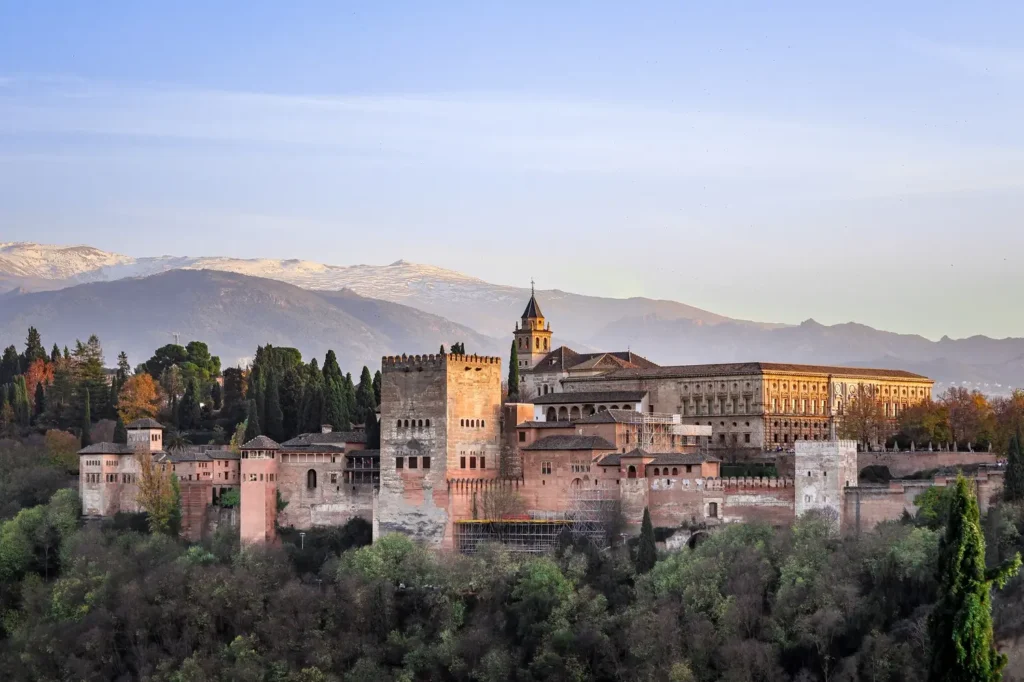
This Granada itinerary is designed to help you uncover the best things to do in Granada. From wandering the Albaicín’s narrow streets to enjoying tapas in traditional restaurants. It’s a mix of breathtaking sights and authentic local experiences.
When I did my road trip through Andalusia back in 2021, I didn’t get to visit Granada, unfortunately. Big mistake! I’ve finally got the chance to visit and let me tell you that it has become one of my favourite places in this Spanish region. Now, I can’t wait to share my tips to help you fall in love with Granada too.
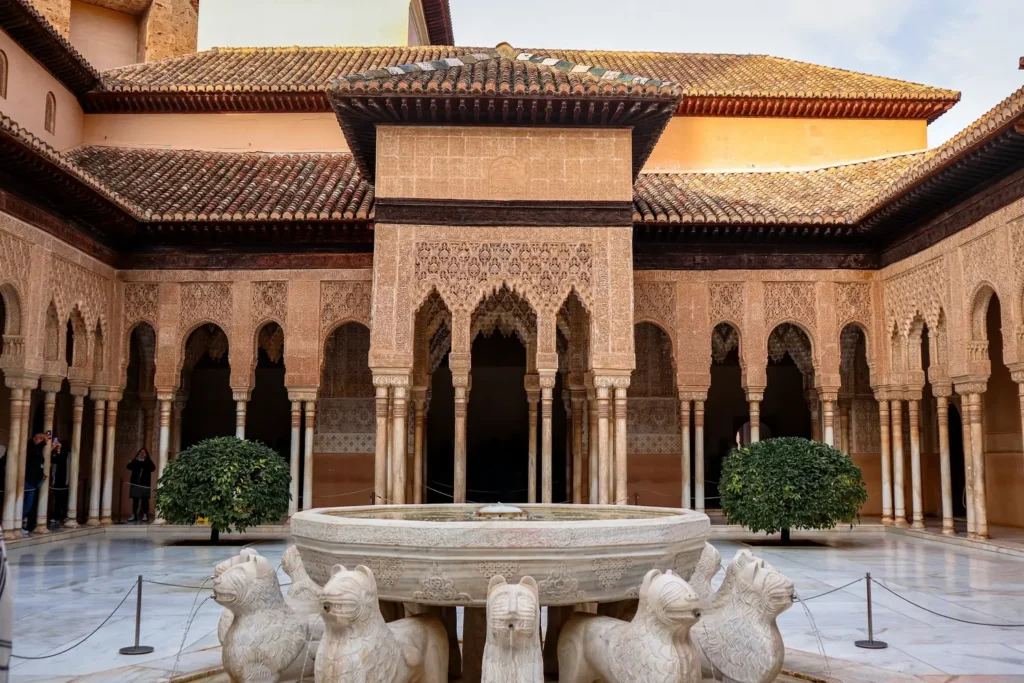
In this Granada guide, you’ll get a detailed itinerary, travel tips, and recommendations to make the most of your visit. Keep reading to find out:
- Best time to visit Granada
- How many days in Granada
- Where to stay in Granada
- Must-try restaurants in Granada
- Best things to do in Granada in 2 days
How many days to spend in Granada?
The ideal time to explore Granada is 2 days. Spending 2 days in Granada allows you to visit the iconic Alhambra, wander through the historic Albaicín, and soak up the city’s vibrant culture without feeling rushed. It’s the perfect balance to experience Granada’s highlights and enjoy its charm.
I spent 48 hours in Granada and felt like it was the perfect amount of time to explore the city’s main sights.
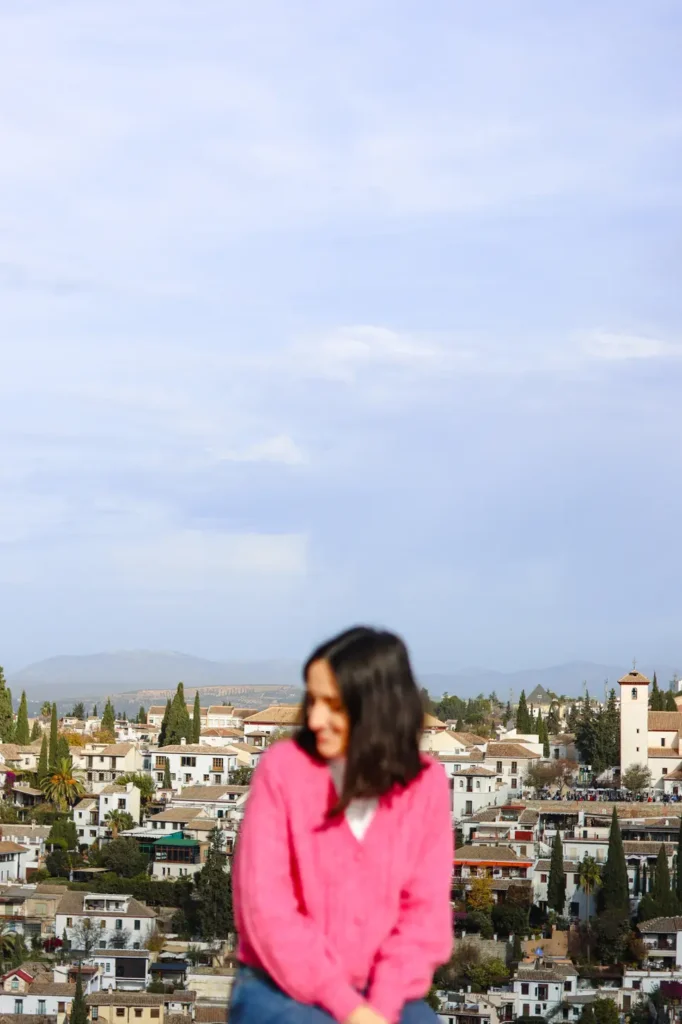
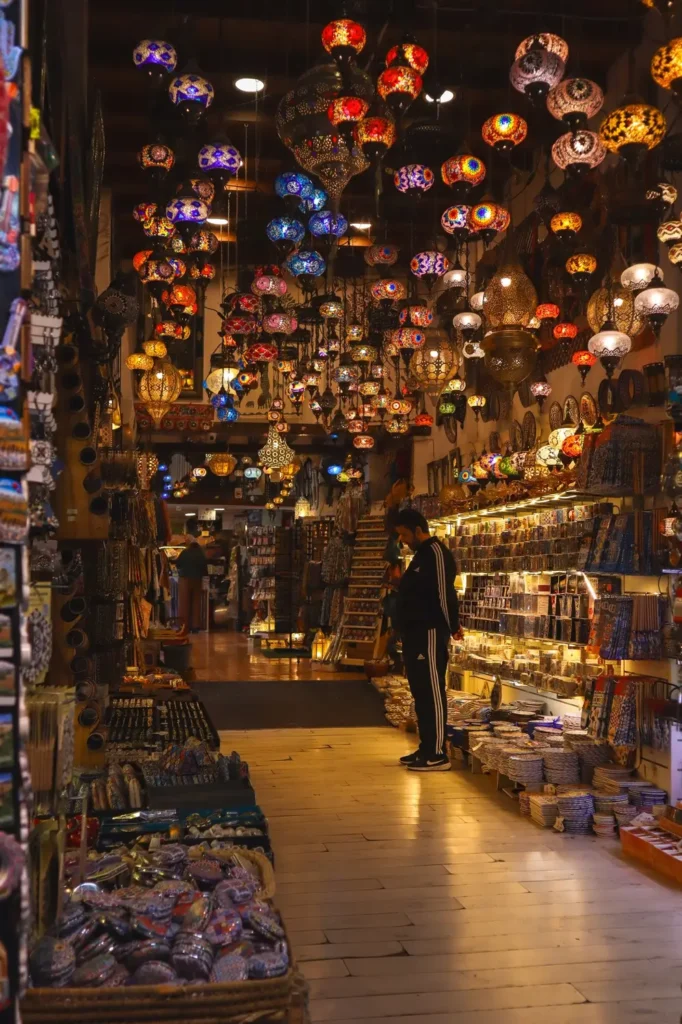
If you’re short on time, don’t worry! I’ve also included a 1-day Granada itinerary for those on a tighter schedule.
💼 TRAVEL INSURANCE: Unexpected events happen anywhere in the world, so I always recommend getting travel insurance. I regularly use Heymondo, which offers some of the highest coverages on the market at very competitive prices. As well as covering medical expenses, Heymondo’s insurance also covers the loss or theft of luggage, electronic equipment and more. They also have a 24/7 customer service through their App. As A Ticket to Take Off reader, you get a 5% discount when purchasing Heymondo insurance. The purchase must be made using this link, and the price shown on the website already includes the discount.
Accommodation in Granada
The best area to stay is the city centre or the Albaicín neighbourhood. These areas offer easy access to major attractions. This includes the Alhambra, the Granada Cathedral, and the Albaicín’s charming cobbled streets. Staying here means you can explore most of the city on foot while soaking in the historic atmosphere.
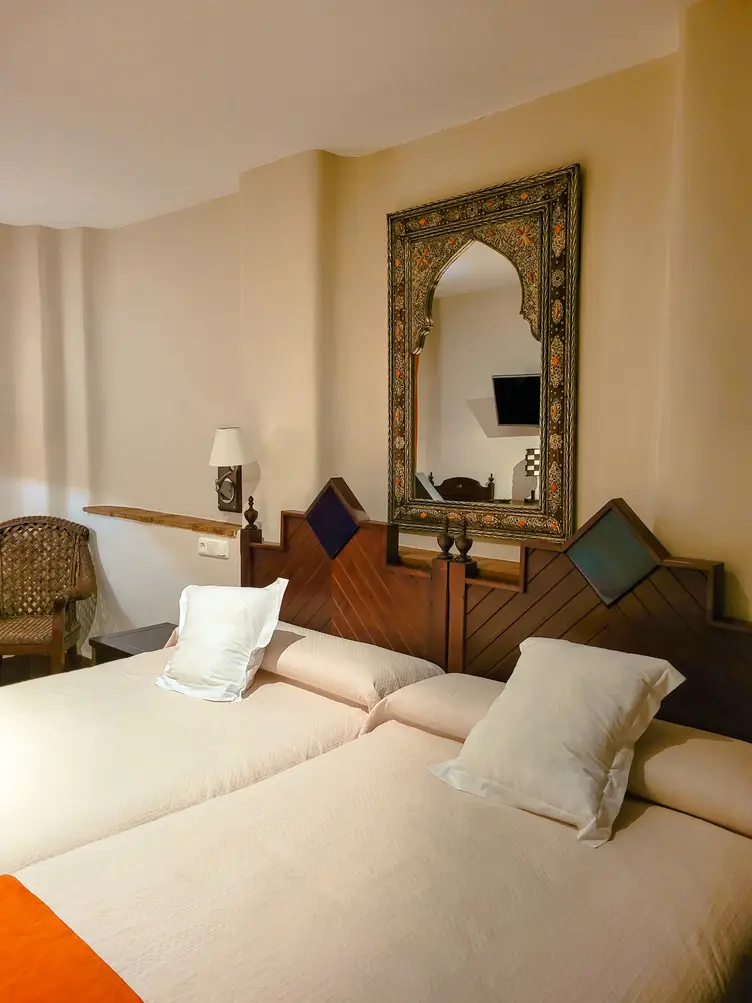
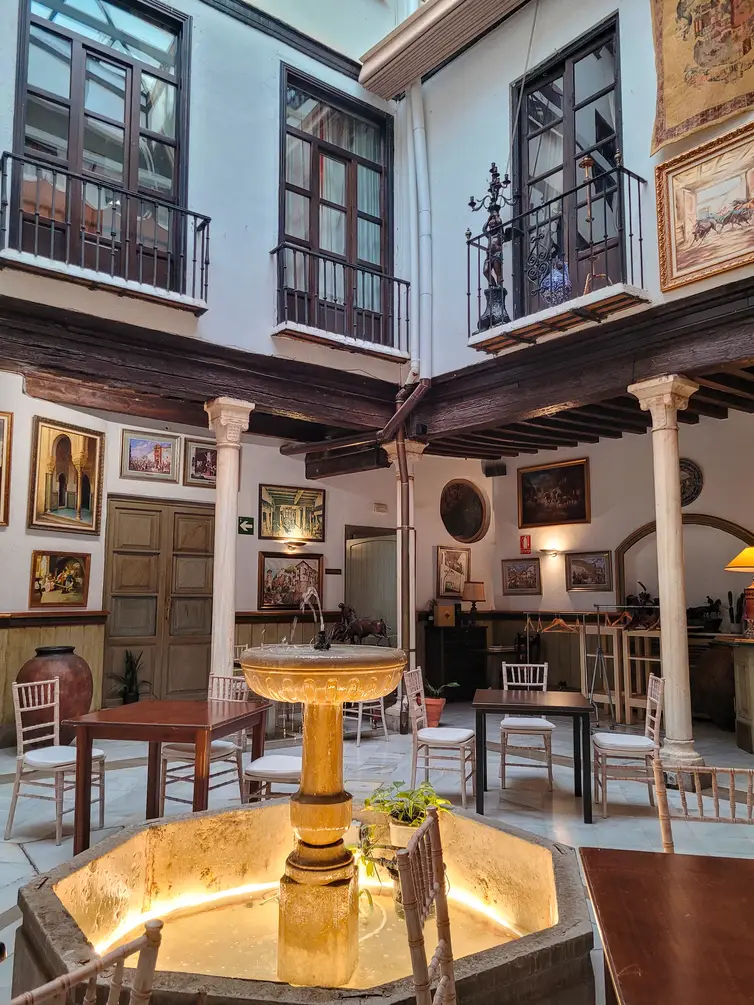
During my visit, I stayed at Casa Palacio Pilar Del Toro. This is a stunning boutique hotel that blends traditional Andalusian charm with modern comfort. The hotel’s central location was ideal for exploring Granada’s highlights. If you’re looking for a cosy, well-located accommodation, I can’t recommend it enough!
No matter where you stay, look for places that offer convenient amenities like parking (if you’re driving) and easy access to public transport. For example, at Casa Palacio Pilar del Toro, parking was 25€/night.
Here are some of my favourite accommodation options in Granada for every budget:
Activities & Tours in Granada
Granada in 2 Days Map
To make planning your Granada trip even easier, here’s a map featuring all the top things to do in Granada in 2 days. This handy guide will help you navigate the city and ensure you don’t miss any must-see spots during your visit!
📌HOW TO USE THE MAP: Click on the top left corner to access the various layers of the map. You can select the layers you’re interested in and also find out more about each point of interest by clicking on it in the left-hand sidebar or on the pin on the map. Add the map to your Google Maps by clicking on the star next to the title. To access the map, simply go to Google Maps ‘Saved’ and click on ‘Maps’!
2 Days in Granada Itinerary
The Granada 2-day itinerary I’ve put together is carefully designed to help you make the most of this incredible city. It’s the exact plan I followed during my visit, and it worked perfectly for me, balancing must-see landmarks with time to soak in Granada’s unique charm.
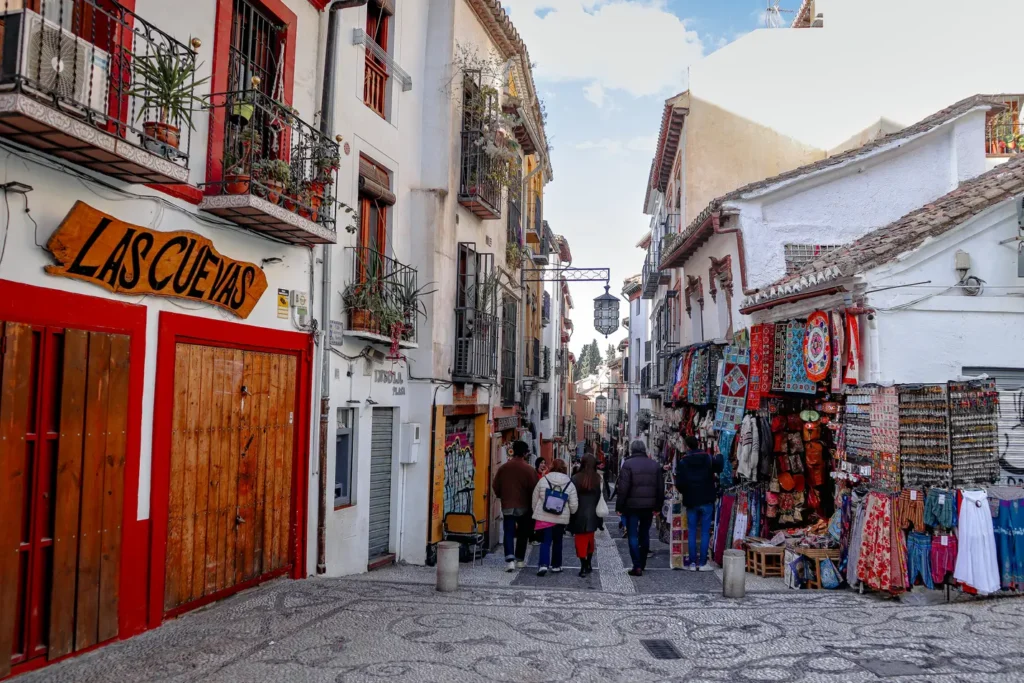
Day 1 in Granada: Morning
» Plaza Nueva
Start your Granada itinerary at Plaza Nueva, the city’s oldest square, located at the foot of the Albaicín —one of Granada’s most iconic neighbourhoods.
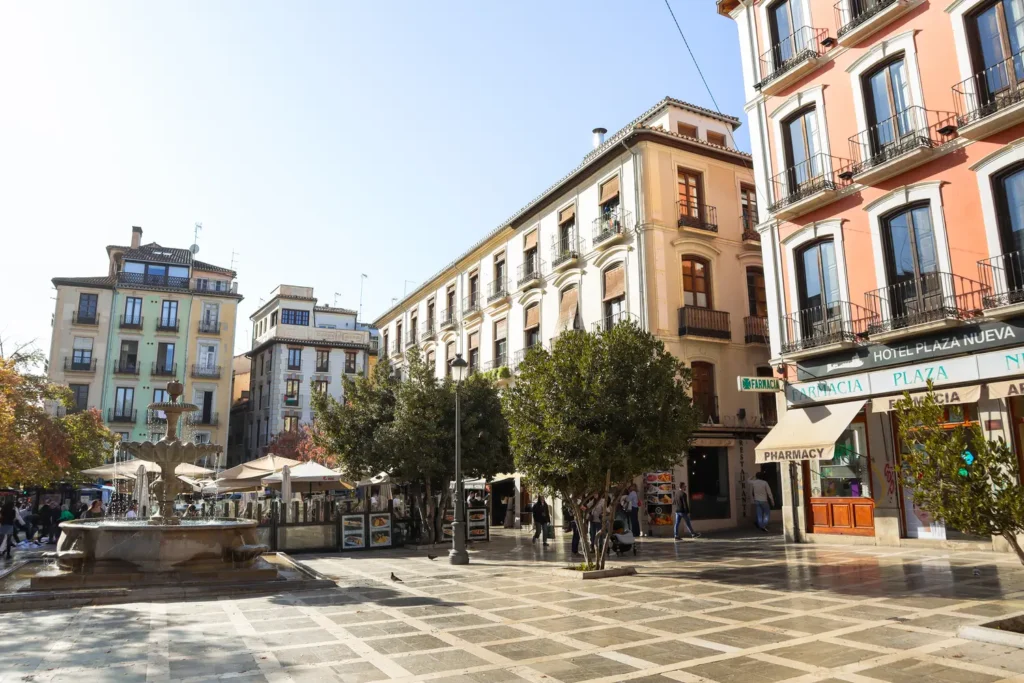
This vibrant square is surrounded by historic buildings and lively cafés. It’s the ideal spot to soak in the atmosphere before diving into exploring the city.
Don’t miss the Church of Santa Ana, the Royal Chancellery (Real Chancillería), and the San Gil and Santa Ana Fountain.
» Calle Caldería Nueva
Head to one of the best streets for shopping in Granada – Calle Caldería Nueva. This is where you’ll start feeling the city’s Arab influence.
Calle Calderería Nueva, often called Granada’s “Little Morocco,” is a vibrant street lined with colourful tea shops, artisan stalls, and Middle Eastern eateries.
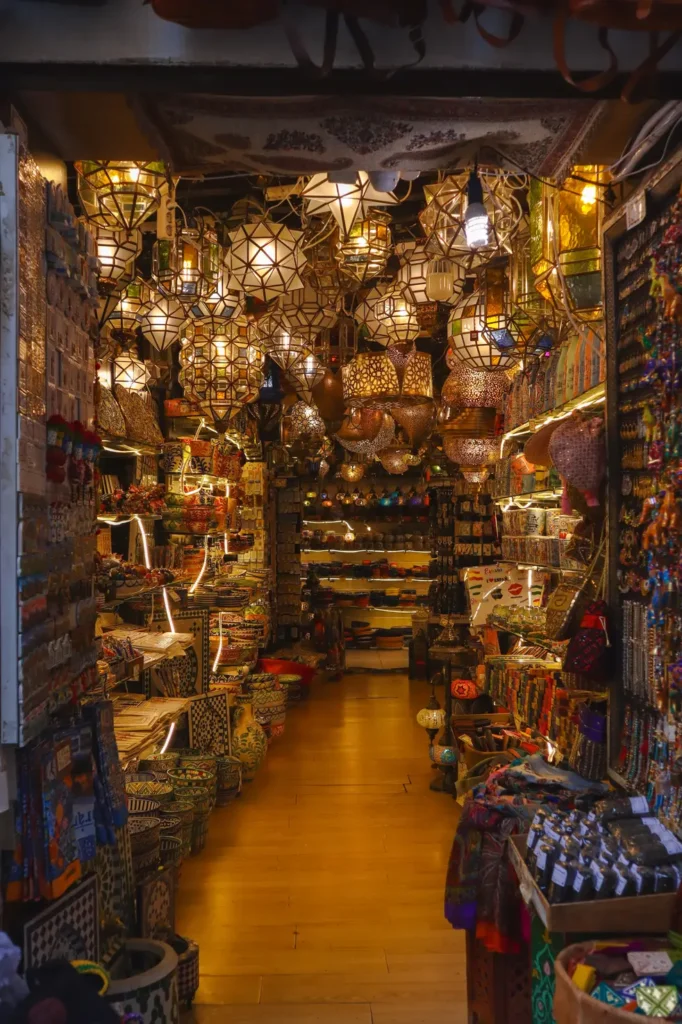
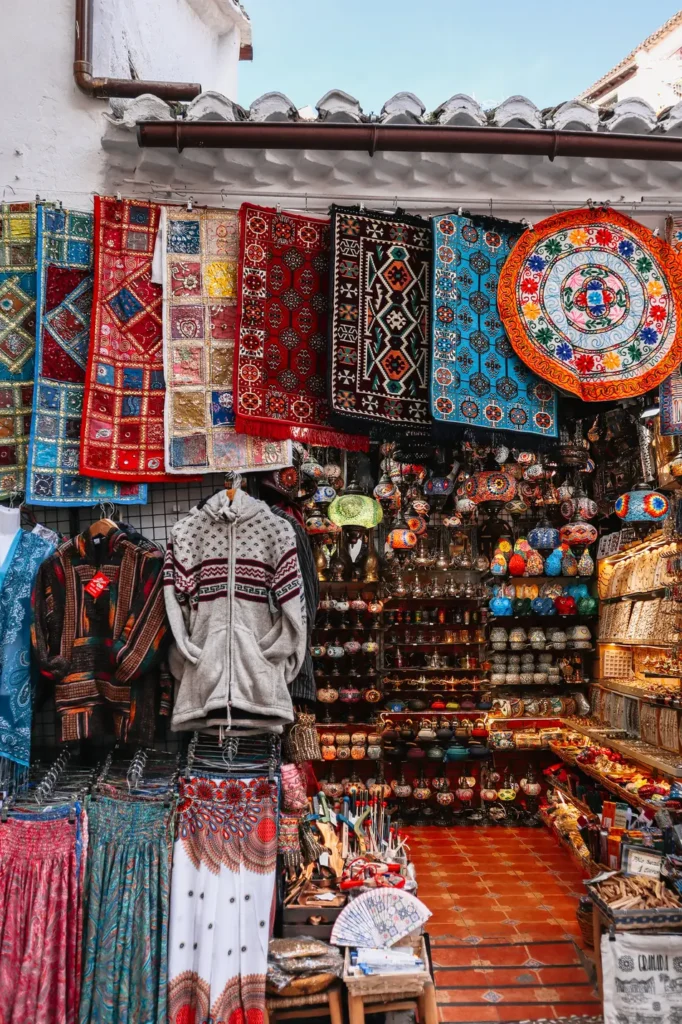
Known for its aromatic spices and handmade goods, it’s the perfect place to immerse yourself in Granada’s Moorish heritage.
Keep in mind that most shops open around 10.30 to 11 am, so plan your itinerary accordingly to make the most of your visit.
» Granada Cathedral
Next on this Granada 2-day itinerary are several churches. And I recommend starting at Granada Cathedral.
Granada Cathedral is a stunning example of Spanish Renaissance architecture and one of the city’s most iconic landmarks.
Built on the site of the former Great Mosque, it symbolises the Catholic monarchs’ victory during the Reconquista (Spain’s centuries-long effort to reclaim land from Muslim rule).
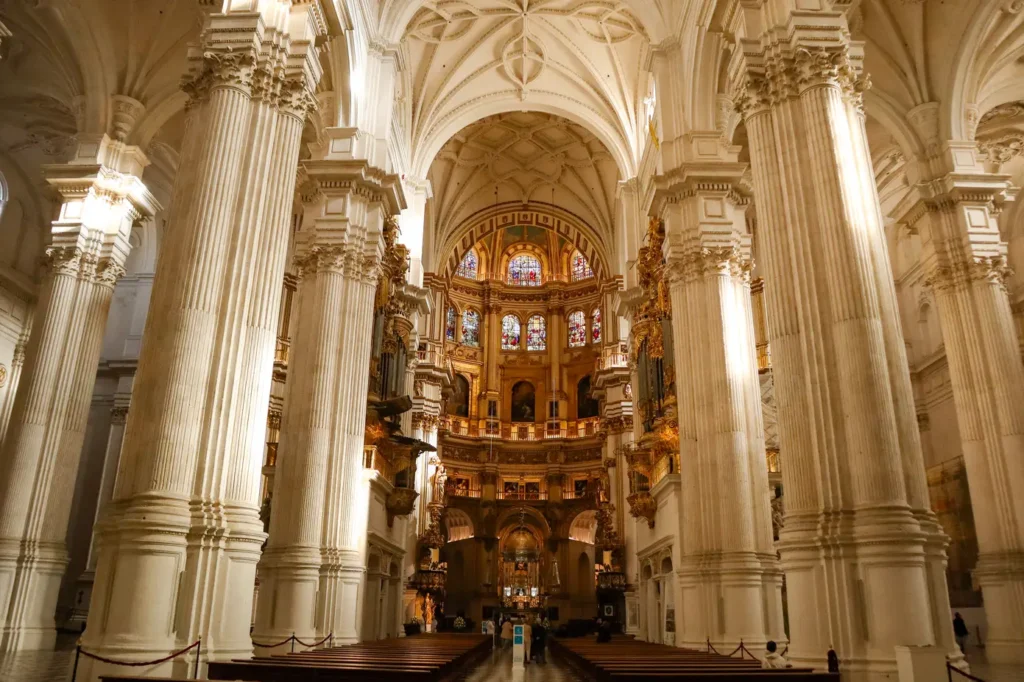
Step inside to marvel at the ornate main altar and the impressive dome, adorned with beautiful artwork and stained-glass windows that flood the space with light. The cathedral is also home to several chapels, each showcasing exquisite sculptures and religious relics.
Visitors receive a free audio guide (accessible on your phone). This will help you enhance your experience with detailed insights into the cathedral’s history and architecture.
📝 USEFUL INFORMATION: The cathedral is open Monday to Saturday from 10 am to 6.15 pm and on Sundays from 3 pm to 6.15 pm. Tickets cost 6€ for adults. For the latest information, visit the official Granada Cathedral website. Save money by buying a combined ticket, which allows you to visit several churches in the city.
» Royal Monastery of San Jerónimo
Relatively close by, you can also visit the Royal Monastery of San Jerónimo. Built in the 16th century, it features a serene cloister adorned with intricate carvings and vibrant frescoes.
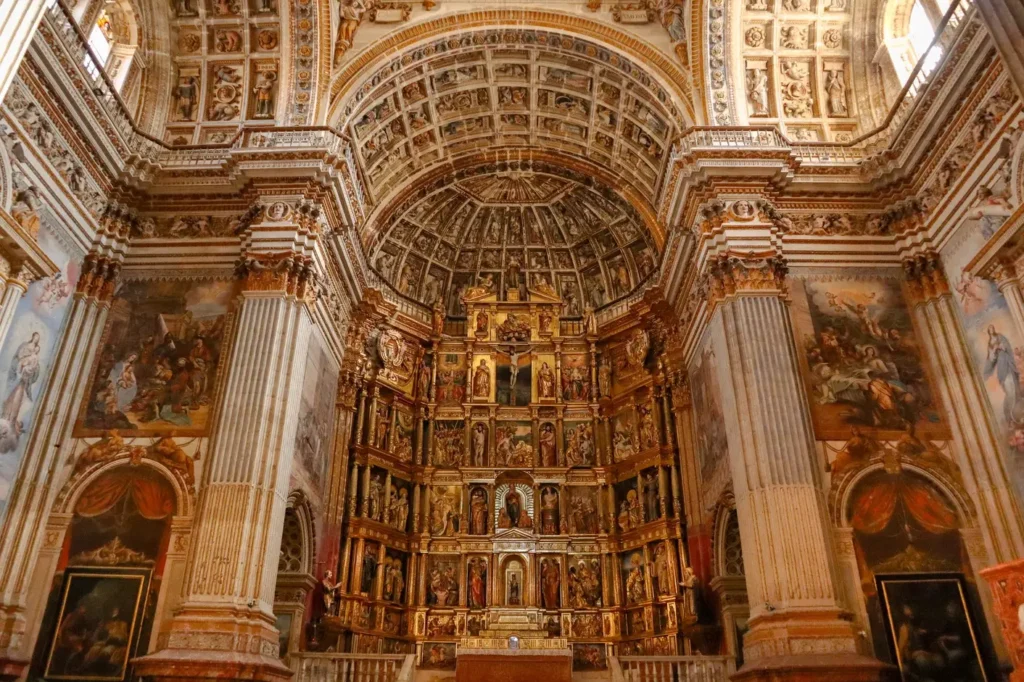
The highlight is the church’s main altar, a masterpiece of Spanish Baroque art. It’s surrounded by golden details and striking sculptures.
📝 USEFUL INFORMATION: The opening hours of the monastery vary according to the day of the week and time of the year. Tickets cost 6€ for adults. I recommend checking out the official website to learn more about the latest opening hours and prices. This church is also included in the combined ticket. A free audio guide is included in the price.
» Royal Chapel of Granada
Another highlight of Granada is its Royal Chapel. Even though it’s the smaller church I mention in this itinerary, you might want to consider it on your Granada itinerary.
The Royal Chapel of Granada is a historic site where Catholic Monarchs Ferdinand and Isabella are entombed. That’s why it’s so special.
Built in the 16th century, it combines Gothic and Renaissance architectural styles and features an intricately decorated interior.
Highlights include the monarchs’ marble tombs, the ornate altarpiece, and a small museum. The museum showcases their personal belongings and religious art.
Be aware that you can’t take any photos inside and they are very strict about it!
📝 USEFUL INFORMATION: The Royal Chapel is open from Monday to Saturday from 10 am to 6.30 pm and on Sunday from 11 am to 6.30 pm. Tickets cost 6€ for adults (audio guide on mobile phone included). For the most updated information, check out their official website. This Royal Chapel is also included in the combined ticket.
» La Alcaicería
It’s time to take a break from religious landmarks and dive back into the vibrant world of shopping (even if it’s just for the experience!). Head to La Alcaicería – Granada’s historic Moorish bazaar.
It was a bustling silk market during the Nasrid dynasty. Though much of the original structure was destroyed in a fire in the 19th century, it has been reconstructed to keep its traditional charm.
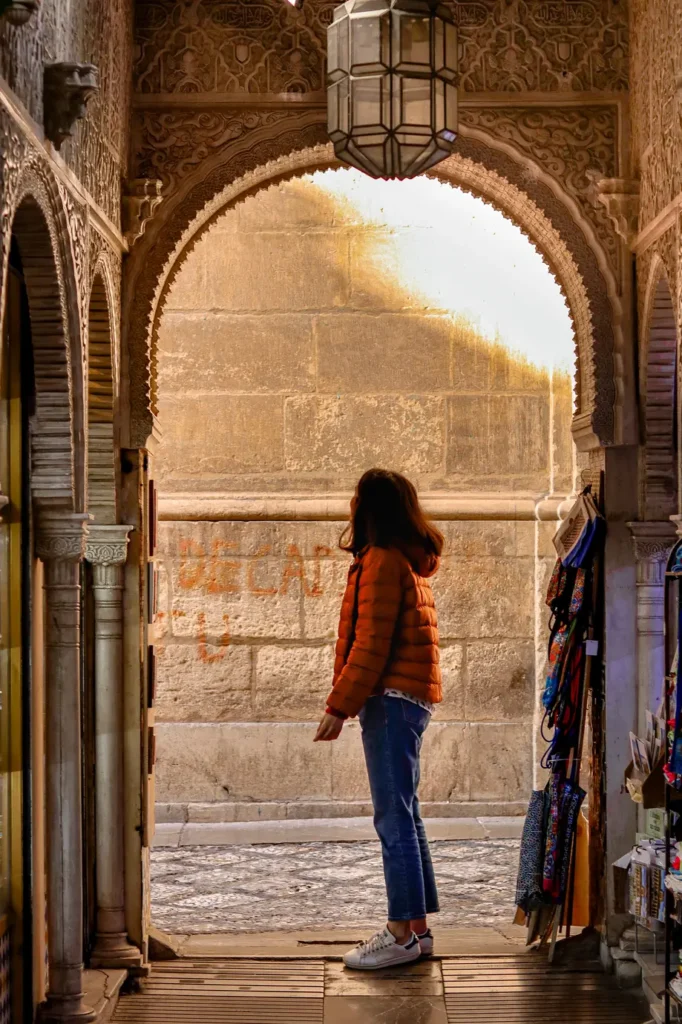
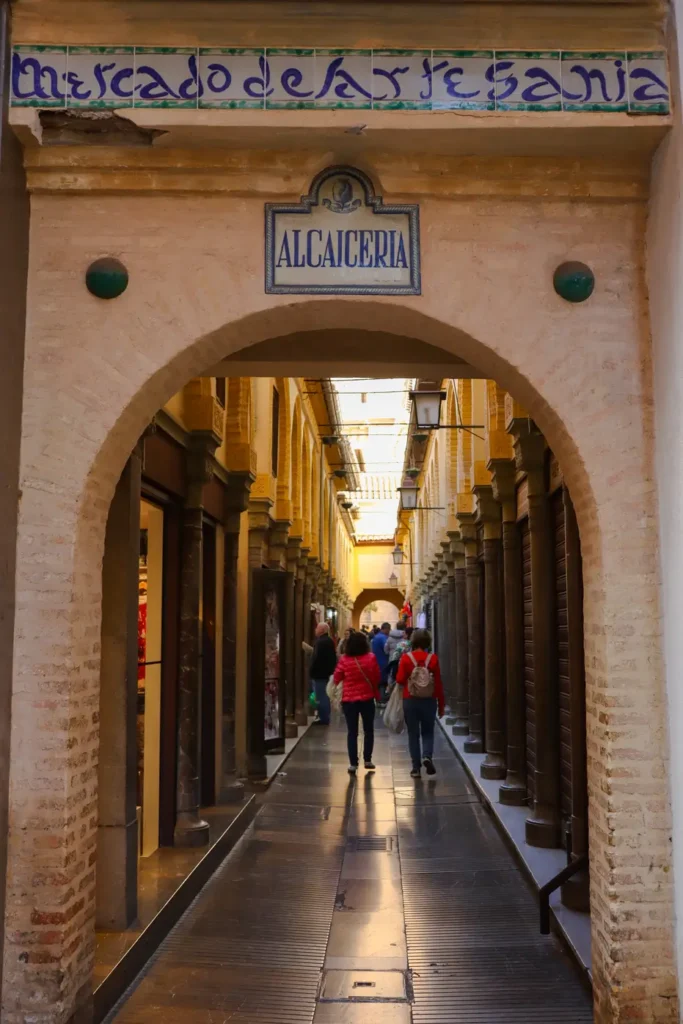
Today, the Alcaicería is a lively network of narrow streets lined with shops selling handcrafted goods, colourful ceramics, intricate textiles, and souvenirs.
It’s the perfect place to find a souvenir to take back home.
» Corral del Carbón
In the heart of Granada, you’ll also find Corral del Carbón. This is a well-preserved 14th-century Moorish structure that once served as a merchant’s inn and marketplace.
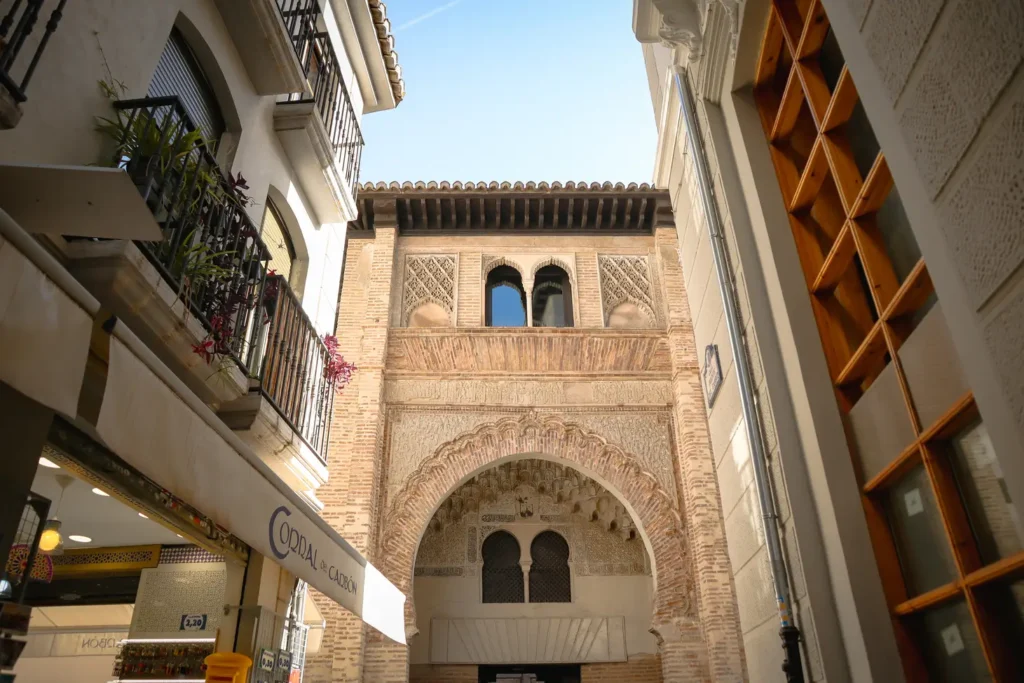
Corral del Carbón features a striking arched entrance with intricate carvings, leading to a peaceful courtyard. Today, it’s a cultural space hosting exhibitions, events, and traditional performances. It offers visitors a glimpse into Granada’s rich past and it’s free to visit.
💡 EXTRA TIP: Book a walking guided tour of the historic centre of Granada to make the most of your visit.
» Bib Rambla Square
End your first morning in Granada at Bib Rambla Square, where you’ll find some cafés, restaurants and shops. For example, since I visited in December, there were many stalls selling Christmas ornaments.
Once a site for medieval tournaments and public events, it’s now a popular spot for both locals and visitors to relax and enjoy the atmosphere. Don’t miss the Fountain of the Giants, standing at its centre.
Day 1 in Granada: Afternoon
» Sacromonte
The afternoon of this Granada itinerary will take you to the unique and fascinating neighbourhood of Sacromonte. Known as the heart of Granada’s flamenco culture, this area is famous for many things. This includes its whitewashed cave houses, dramatic hillside views, and vibrant artistic spirit.
The Sacromonte caves were created by the gypsy community who settled in Granada after the Reconquista in the late 15th century. Seeking refuge and a place to call home, they carved dwellings into the soft hills of Sacromonte.
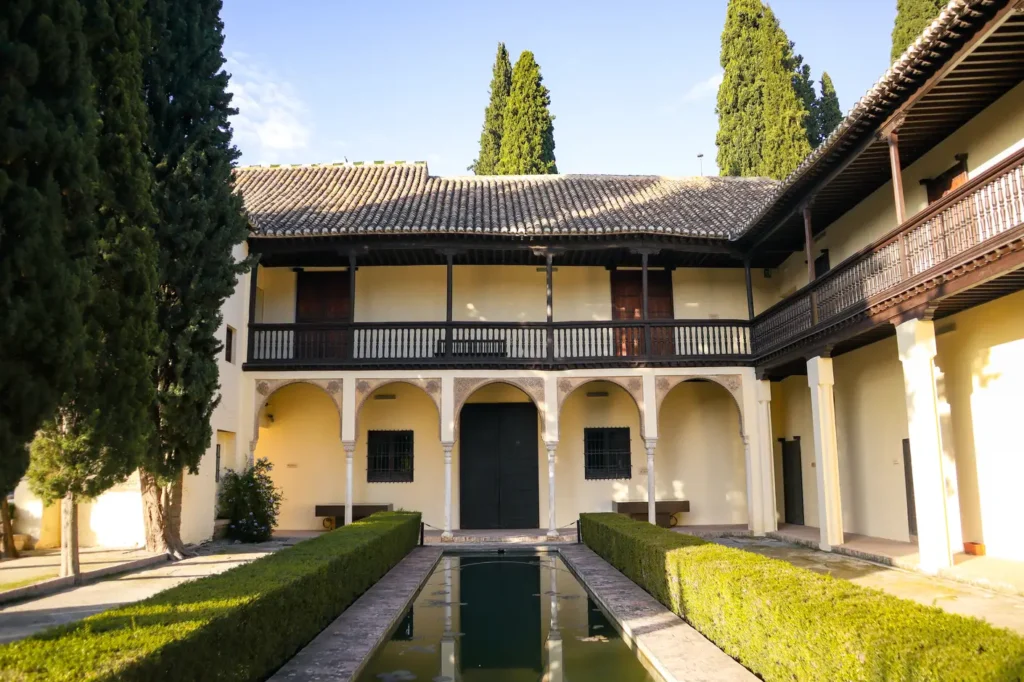
Today, the caves are a symbol of the area’s artistic heritage. Many are still inhabited or transformed into flamenco venues, museums, and cultural spaces.
Wandering through Sacromonte feels like stepping into a different part of Granada. You’ll explore its charming streets, learn about its rich history, and soak up breathtaking vistas of the Alhambra framed by the Sierra Nevada mountains.
You can simply stroll around Sacromonte but there are a few must-see spots you shouldn’t miss. These include Sacromonte Viewpoint, Casa del Chapiz, a traditional flamenco show or Palacio de los Córdova. I’ll get more in detail in just a bit.
💡 EXTRA TIP: Sacromonte is located on a hill, so it’s a bit of a climb walking there. If you don’t want to walk there, get there by using Granada’s city buses (a one-way journey costs 1.6€ and you can tap your credit/debit card to pay for the trip). Hop on the C31, C32 or C34, which run frequently from the city centre and drop you off near the main attractions.
» Sacromonte Viewpoint
Since Sacromonte is located on the hills, you often get breathtaking views from many places in this part of town. One of the best spots to take it all in is the Sacromonte Viewpoint. This is a peaceful location that offers stunning panoramas of the Alhambra, the Albaicín, and the Sierra Nevada mountains.
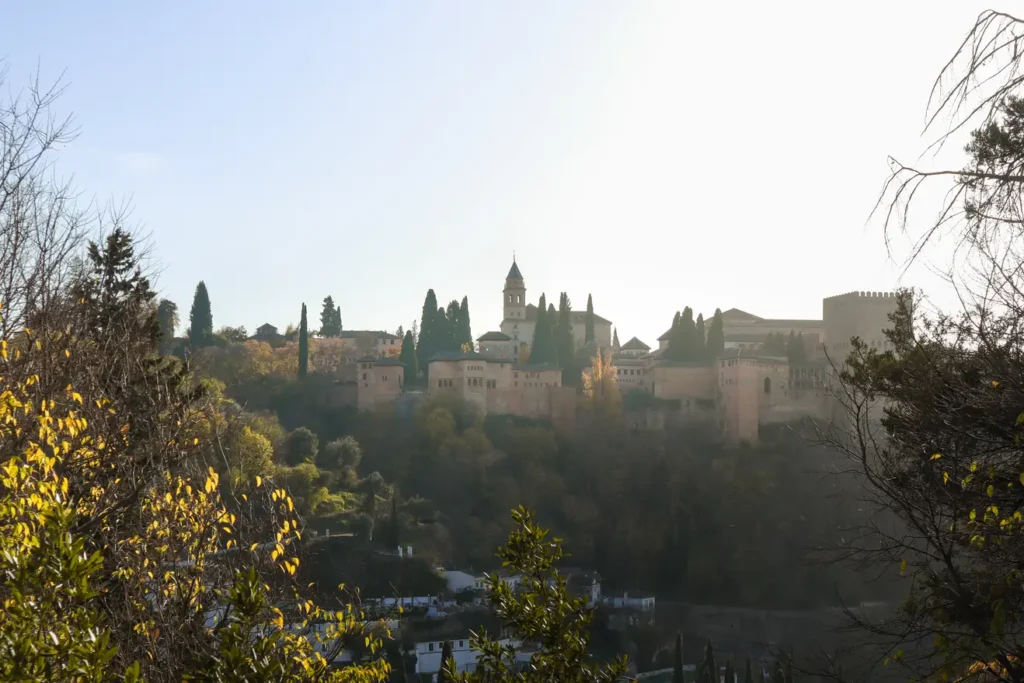
It’s a quieter alternative to the more crowded Mirador de San Nicolás (which I’ll mention later on). However, it’s best to avoid visiting when the sun is descending, as the harsh light can affect your photos. For instance, I visited at 4 pm in December and the photos didn’t turn out that great.
» Casa del Chapiz
Casa del Chapiz is a beautifully preserved 16th-century Moorish residence located in Sacromonte.
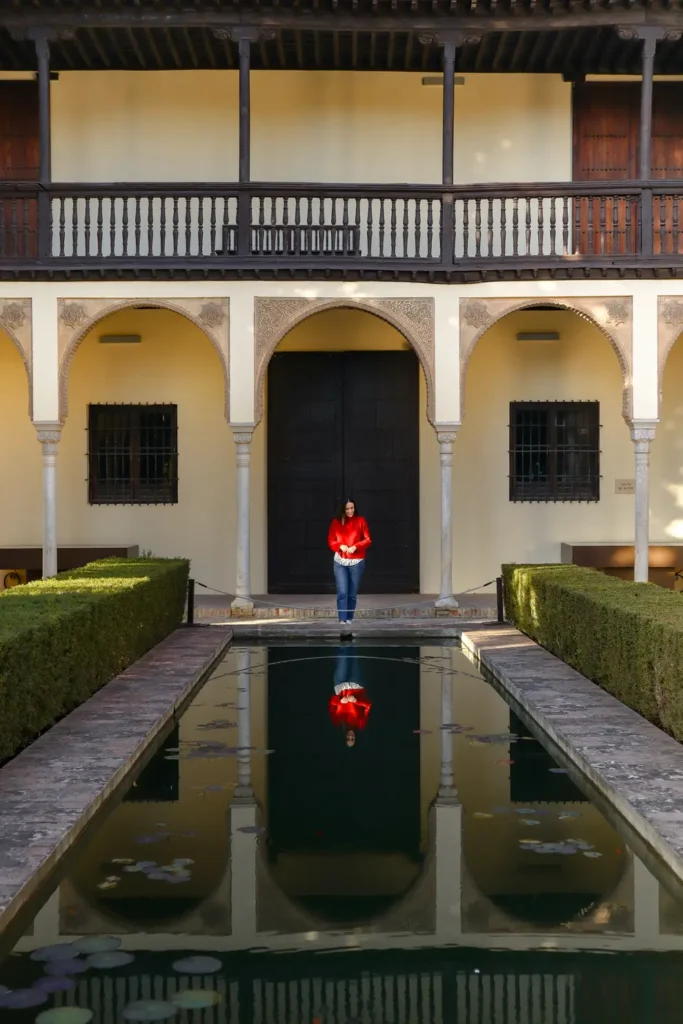
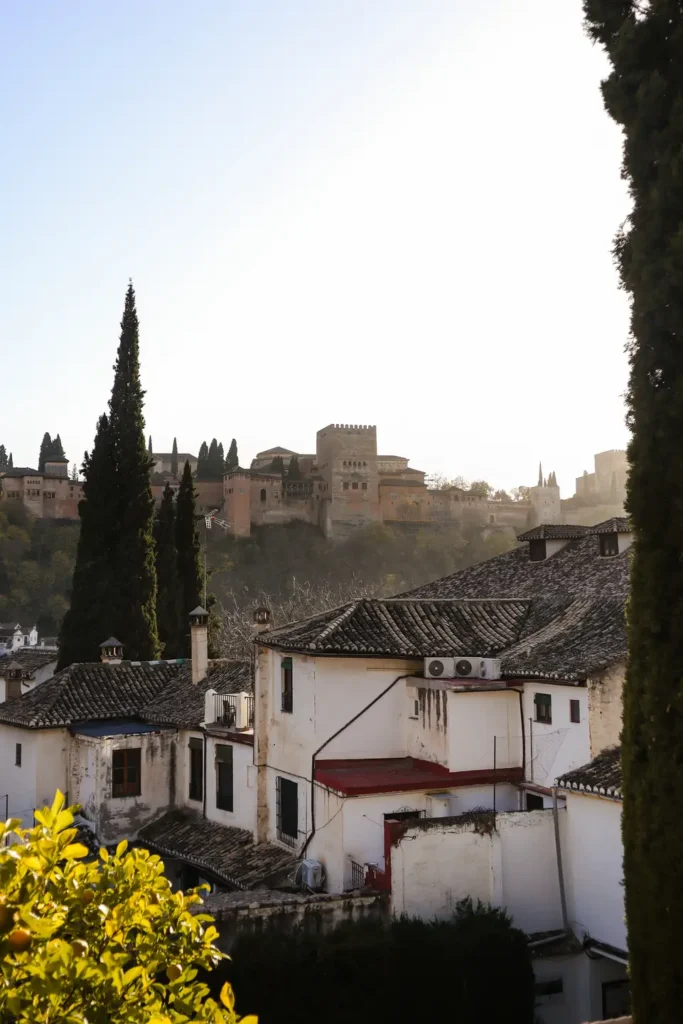
It showcases traditional Nasrid architecture, with stunning wooden ceilings, intricate details, and peaceful courtyards. When I visited, there was no one around and the gardens have amazing views over the Alhambra and the surrounding landscape.
📝 USEFUL INFORMATION: It costs 2€ per person to visit Casa del Chapiz.
Another popular place to visit nearby is Carmen de la Victoria. This is a picturesque garden with breathtaking views of the Alhambra and the Sierra Nevada mountains. Unfortunately, it was closed for renovations when I visited.
» Palacio de los Córdova
Another must-see in this part of town is Palacio de los Córdova. This is a Renaissance-style palace built in the 16th century.
Originally a noble residence, it features beautiful gardens, courtyards, and historic architectural details. Today, it serves as an archive and event space, offering visitors a tranquil setting with stunning views of the Alhambra and the Darro River.
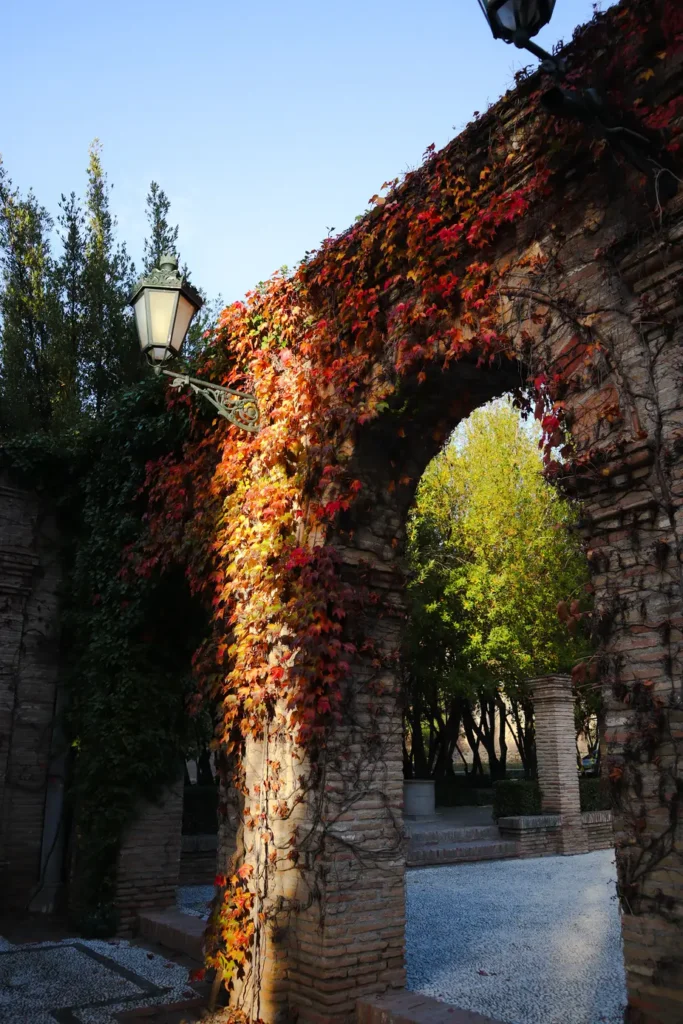
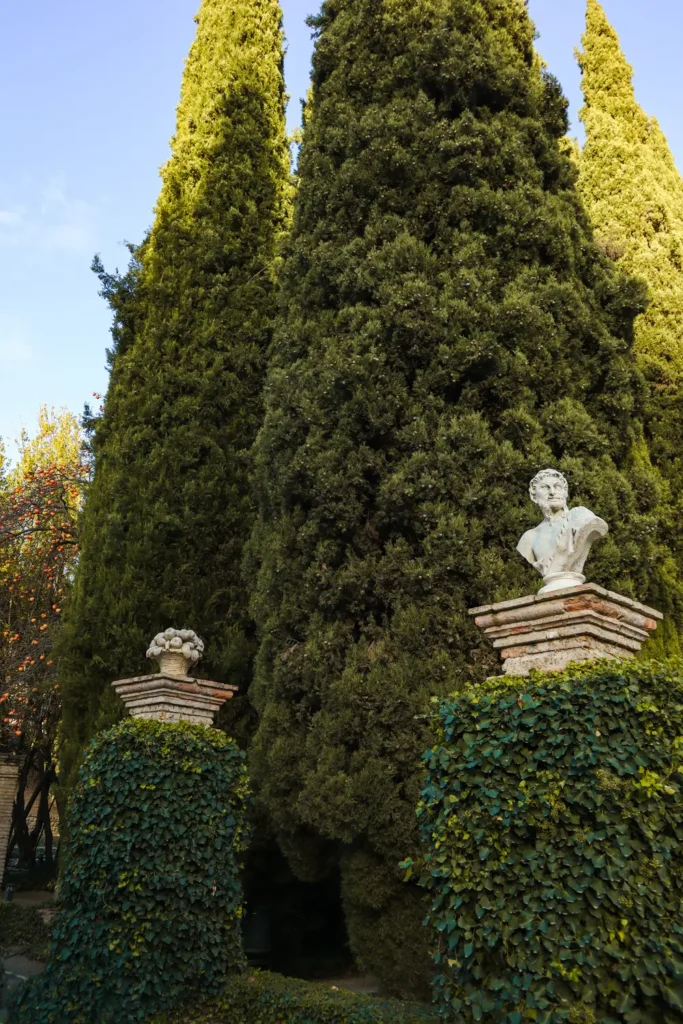
The palace itself may not be the highlight, but the charming garden is well worth a visit, offering lovely views and a peaceful atmosphere.
💡 EXTRA TIP: Even though I didn’t visit myself, if you want to learn more about the history of Sacromonte, I’d visit Sacramonte Caves Museum (Museo Cuevas del Sacromonte), which costs 5€. If you’re short on time, I’d visit this museum instead of Casa del Chapiz and Palacio de los Córdova.
» Albaicín
After exploring Sacromonte, continue to Albaicín – another historic neighbourhood in Granada.
Also perched on a hillside, its narrow, winding streets are a labyrinth of whitewashed houses, flower-filled balconies, and hidden courtyards.
Once the Muslim quarter of the city, its architecture and layout reflect centuries of Arabic influence.
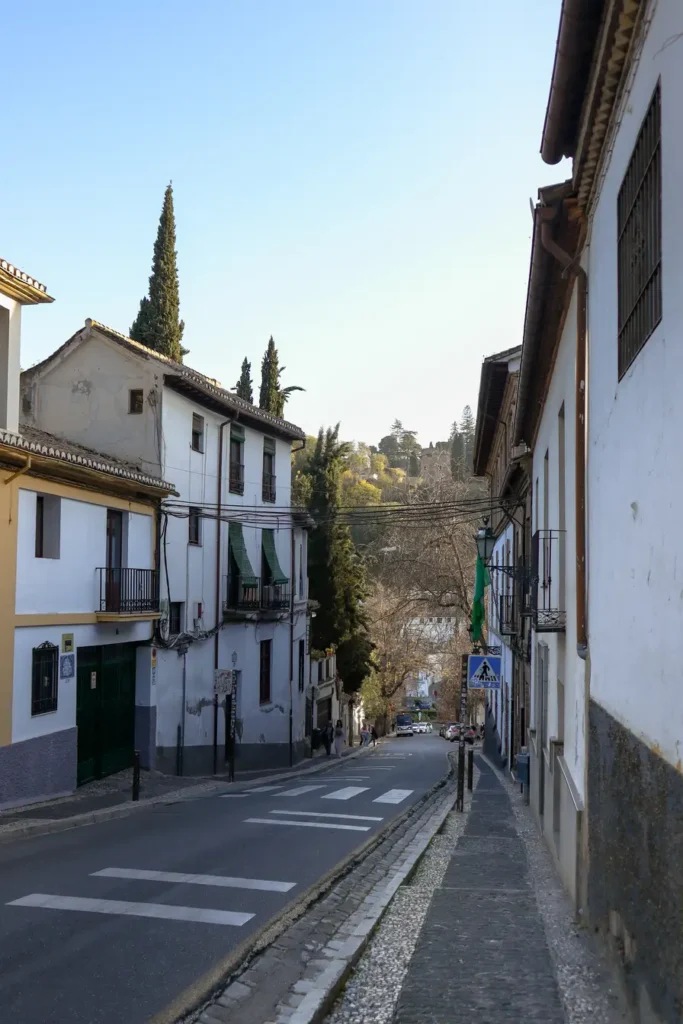
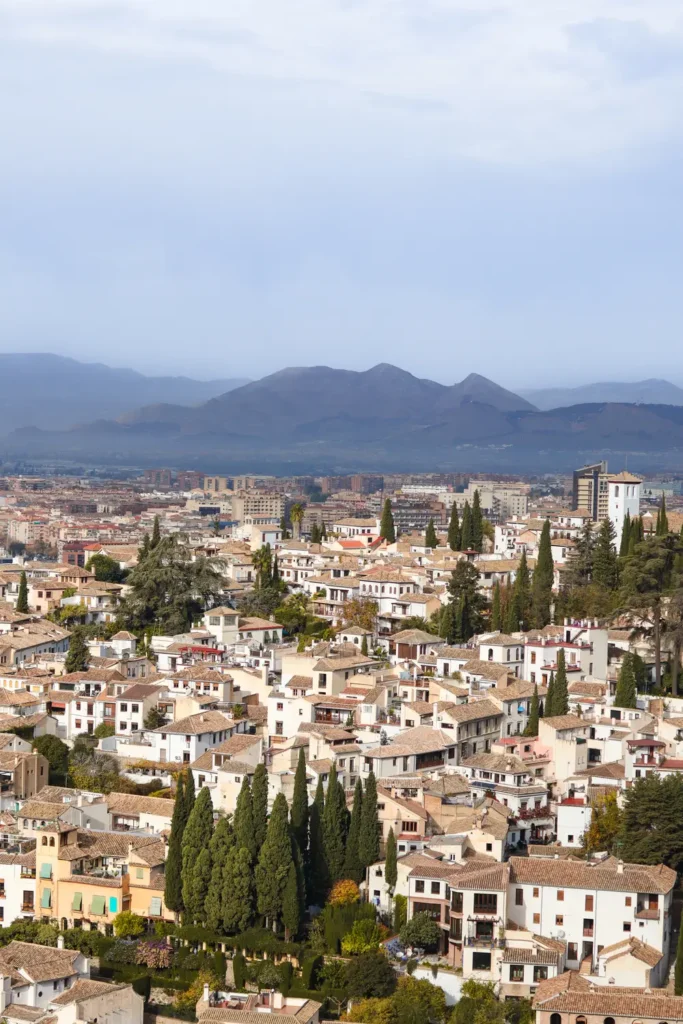
Walking through the Albaicín feels like stepping back in time. The neighbourhood is home to charming squares, bustling tea shops, and stunning viewpoints like the famous Mirador de San Nicolás. This viewpoint offers panoramic views of the Alhambra and Sierra Nevada mountains.
The best way to explore the Albaicín is to simply wander its charming streets and discover its hidden gems at your own pace. However, one spot you absolutely can’t miss is the San Nicolás Viewpoint.
💡EXTRA TIP: Make the most of your visit to the Albaicín with a guided tour of the area. Dive into the rich history of the Albaicín and Sacromonte on this captivating 2-hour sunset tour.
» San Nicolás Viewpoint
San Nicolás Viewpoint (Mirador de San Nicolá) is Granada’s most iconic viewpoint. It’s renowned for its spectacular views of the Alhambra with the Sierra Nevada mountains as a stunning backdrop.
It’s especially magical at sunset when the view becomes even prettier. The view of the Alhambra is absolutely stunning.
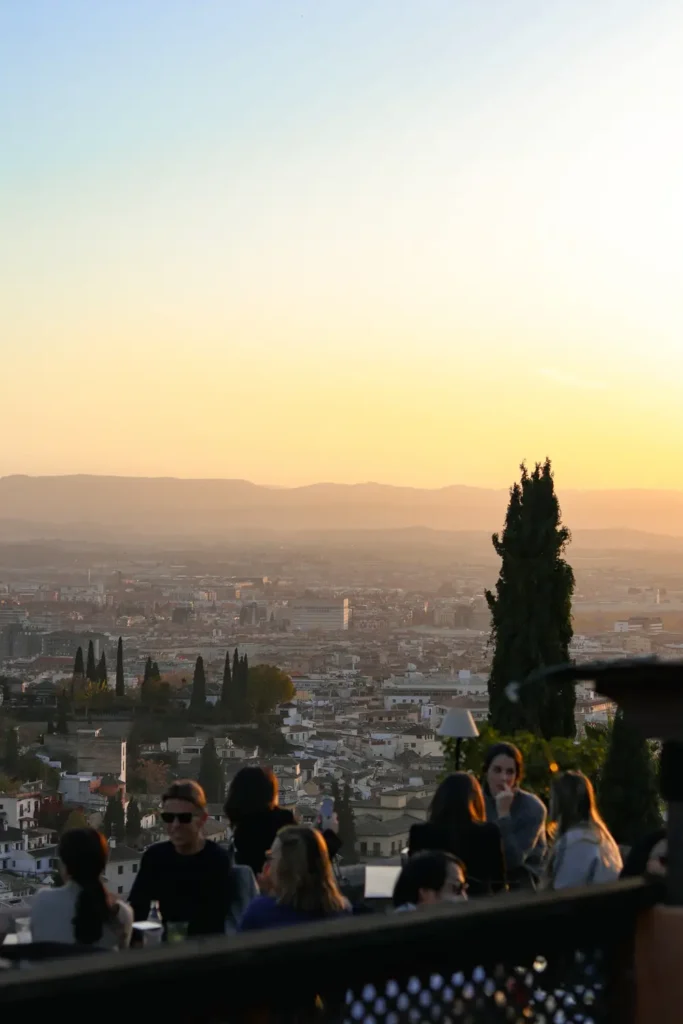
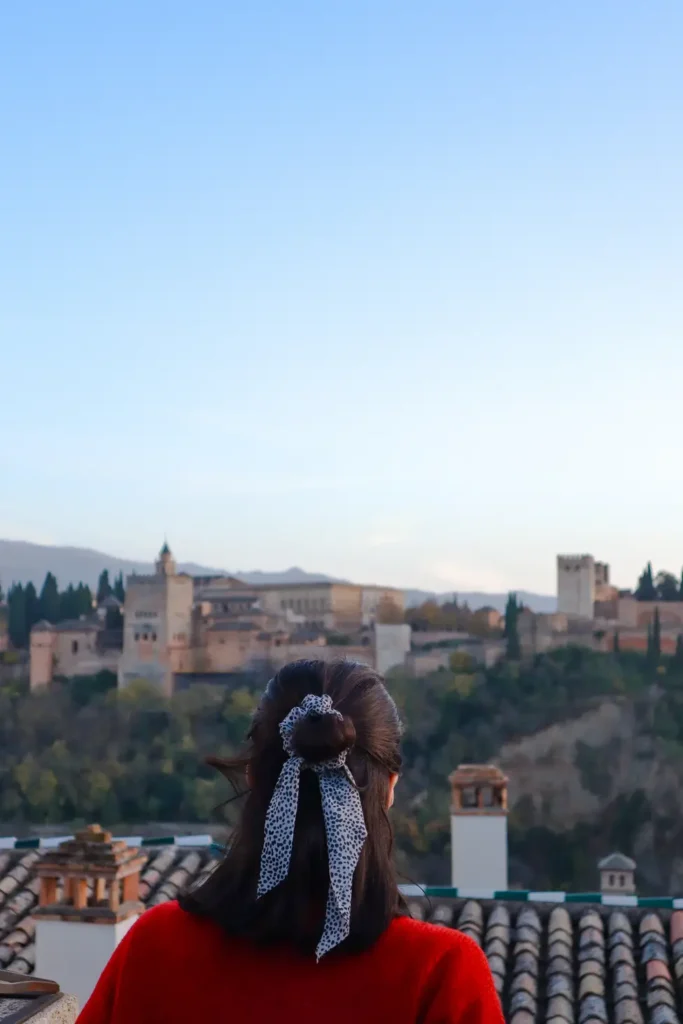
Let me give you a heads-up—don’t expect to have this spot to yourself! The viewpoint was incredibly crowded during my visit, which took away from the experience.
It was nearly impossible to get a photo or even find a spot on the wall to sit and soak in the view. Despite the crowds, the scenery is breathtaking, and that’s why I still recommend it—it’s worth braving the hustle for the stunning panorama.
Day 1 in Granada: Night
» Flamenco Show
End your day with the magic of a traditional flamenco show. Granada offers several fantastic venues, but one of the most popular is Cuevas Los Tarantos, set in the heart of Sacromonte. Shows typically start around 7 pm, with multiple sessions available each evening.
If you’re planning to watch the show at Cuevas Los Tarantos, you’ll need to make your way back to Sacromonte. Fortunately, it’s an easy and enjoyable walk from the Albaicín, letting you soak in the charm of Granada’s streets along the way.
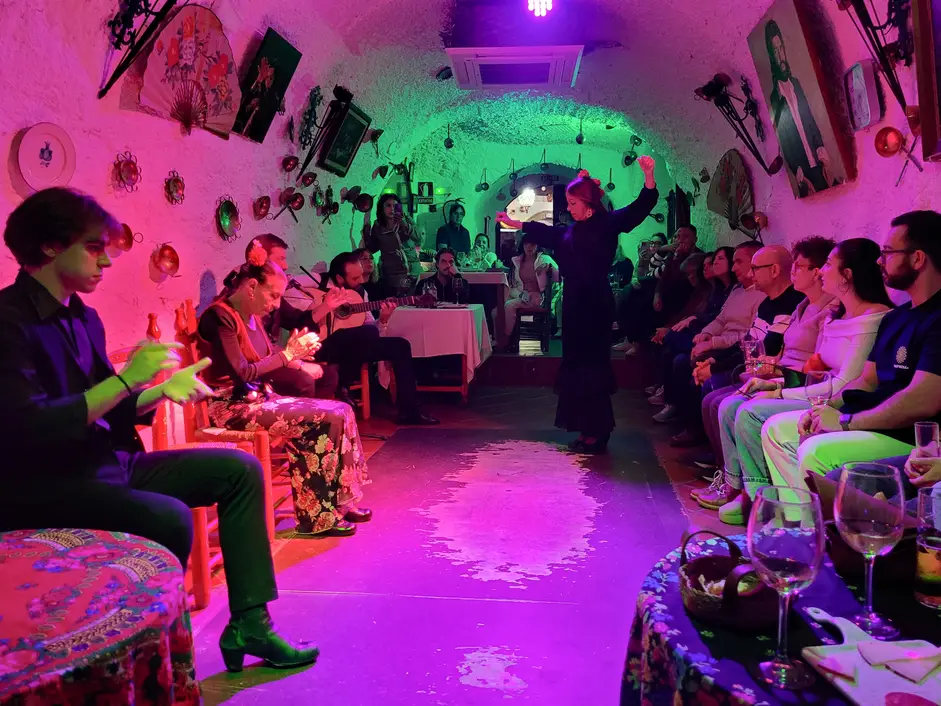
Book your flamenco show tickets in advance since this is quite a popular activity in the city. I purchased my tickets at Get Your Guide for 27€ and it was worth every penny!
This was my first time seeing flamenco live, and it was absolutely unforgettable. Watching the powerful performances and passionate rhythms was a dream come true, especially since I’d wanted to see flamenco since I was a child!
Day 2 in Granada: Morning
» Alhambra
No visit to Granada is complete without exploring the Alhambra. Alhambra is an iconic UNESCO World Heritage Site and a masterpiece of Moorish architecture.
If you only have a few hours in Granada, this is the one place you must see. Many people come to Granada solely to visit the Alhambra—though I think they’re missing out on the city’s other incredible charms!
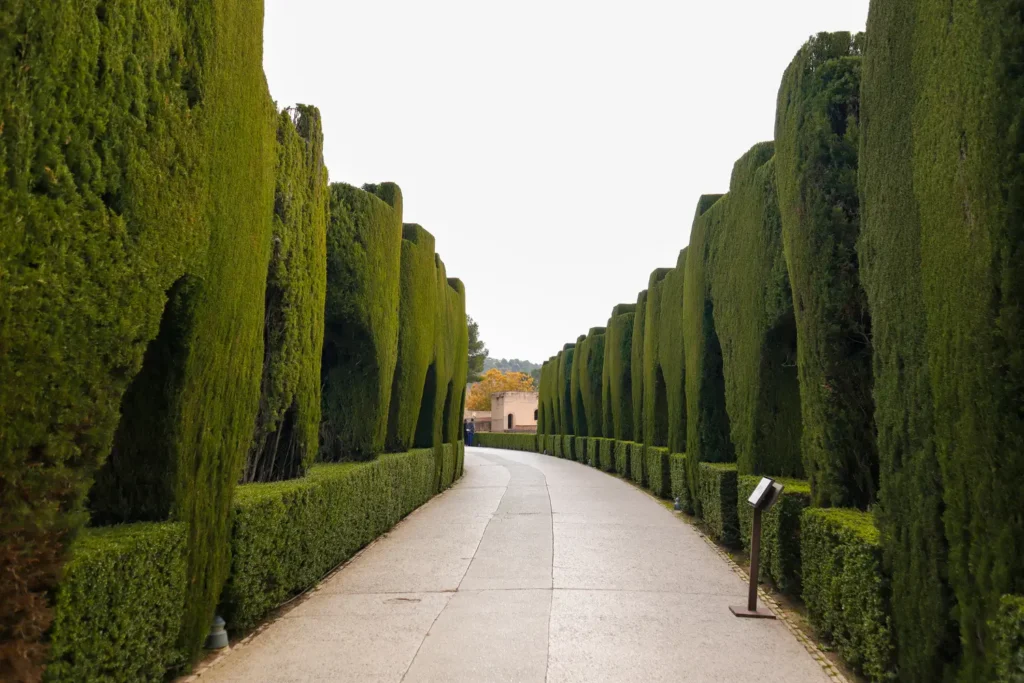
Perched on a hill overlooking the city, the Alhambra complex is enormous. It features stunning palaces, lush gardens, and historic fortresses. Plan to spend at least three hours here to explore its highlights.
Given its vast size, I highly recommend joining an Alhambra guided tour. While you can download an audio guide to your phone, a professional guide will provide deeper insights into this iconic site, making your visit much more rewarding.
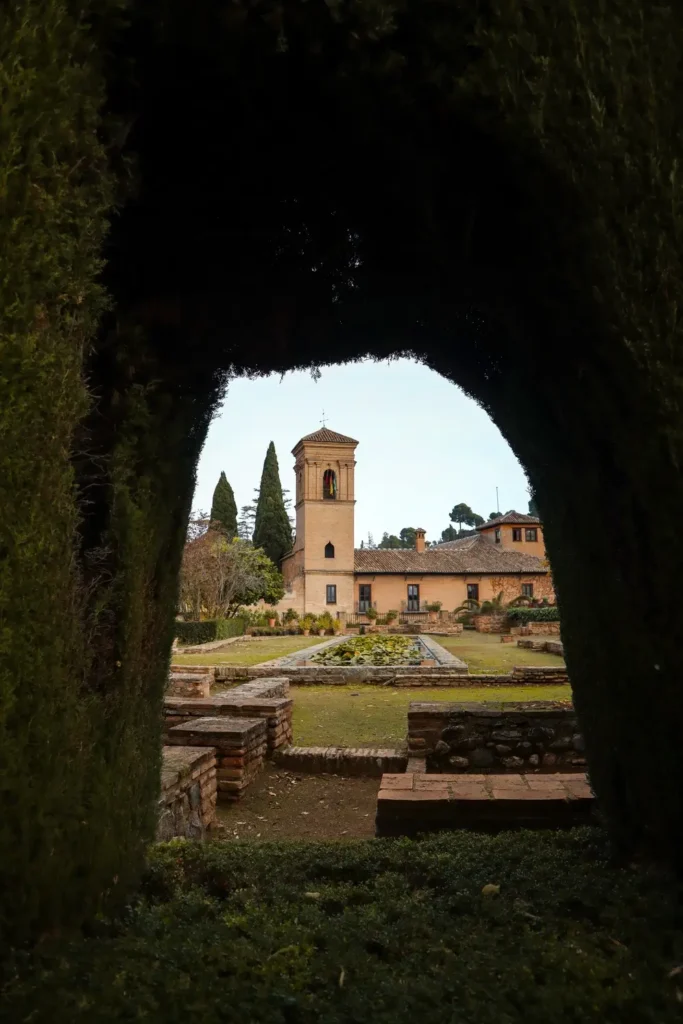
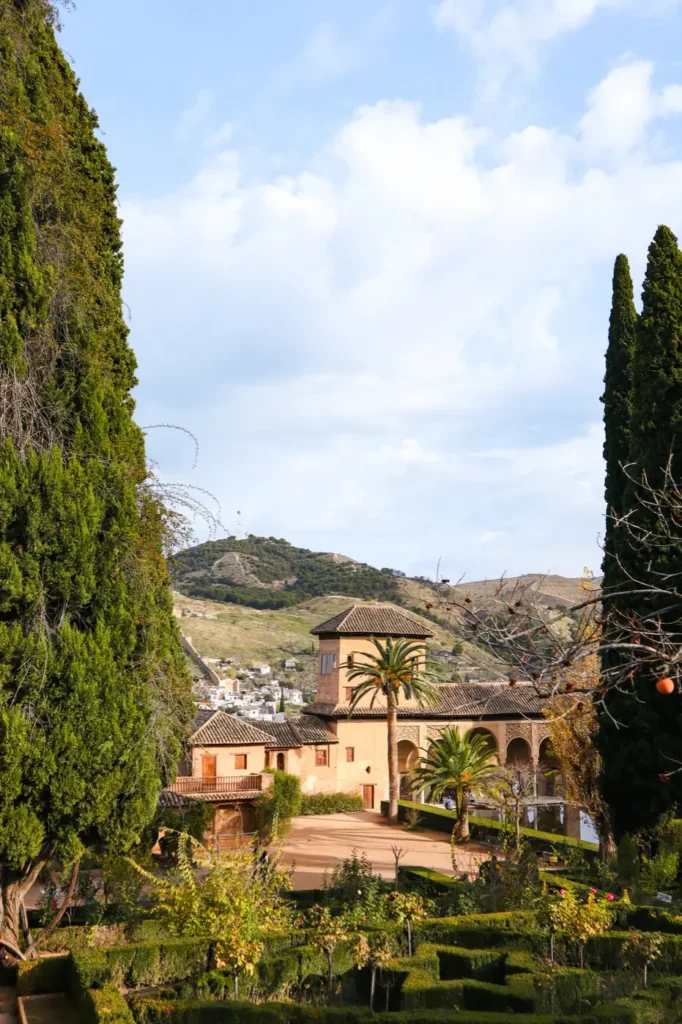
Another important tip is to get your Alhambra tickets as soon as possible. This is Granada’s most popular attraction, and tickets sell out quickly. While a limited number of tickets are released daily, it’s not worth the stress of queuing early and risking disappointment.
📝 USEFUL INFORMATION: The most complete ticket (which includes the Nasrid Palaces) costs 19€. If you’re not booking a guided tour, purchase your tickets from the official Alhambra website for the best price. Don’t forget to bring your ID/passport, as it’s required for entry and will be checked at the gates.
To fully experience the Alhambra, follow this suggested order:
- Begin at the Nasrid Palaces, marvelling at their intricate tilework, carved ceilings, and serene courtyards.
- Continue to the Alcazaba, the fortress area offering breathtaking panoramic views of Granada.
- End your visit at the Generalife, a peaceful summer palace surrounded by lush gardens and fountains.
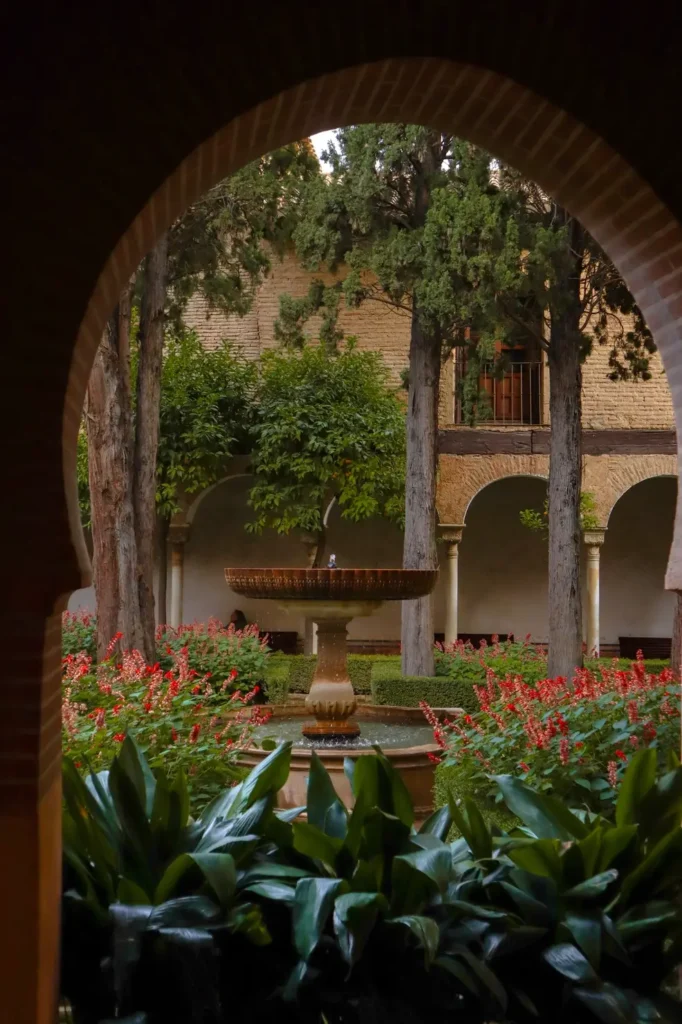
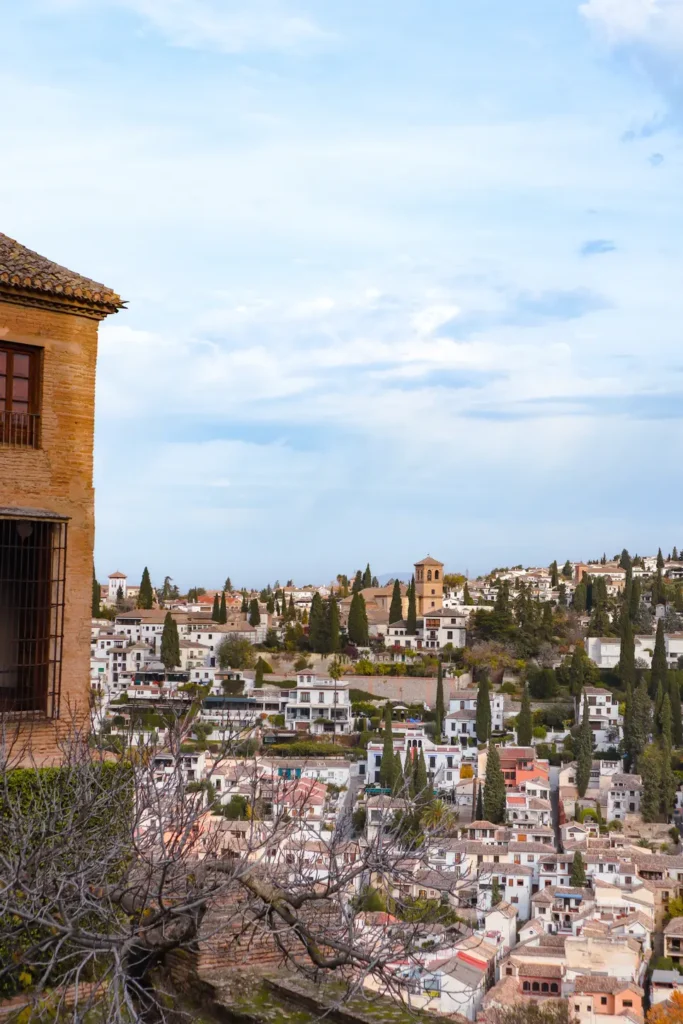
💡 EXTRA TIP: You can reach Alhambra from the city centre by walking (it’s uphill and takes about 20 min), taking the C32 bus or driving. I chose to drive and used the official car park. Parking costs 1.20€ for the first minute and 0.0354€ per minute afterwards, with a daily maximum of 22.4€.
» Nasrid Palaces
The Nasrid Palaces are the crown jewel of the Alhambra. They are known for their intricate architecture and breathtaking beauty. These palaces served as the royal residence of the Nasrid dynasty and are a stunning example of Islamic art and design.
Highlights include the Court of the Lions, with its iconic fountain surrounded by marble arches, and the Hall of the Ambassadors, featuring a stunning dome and intricate geometric patterns.
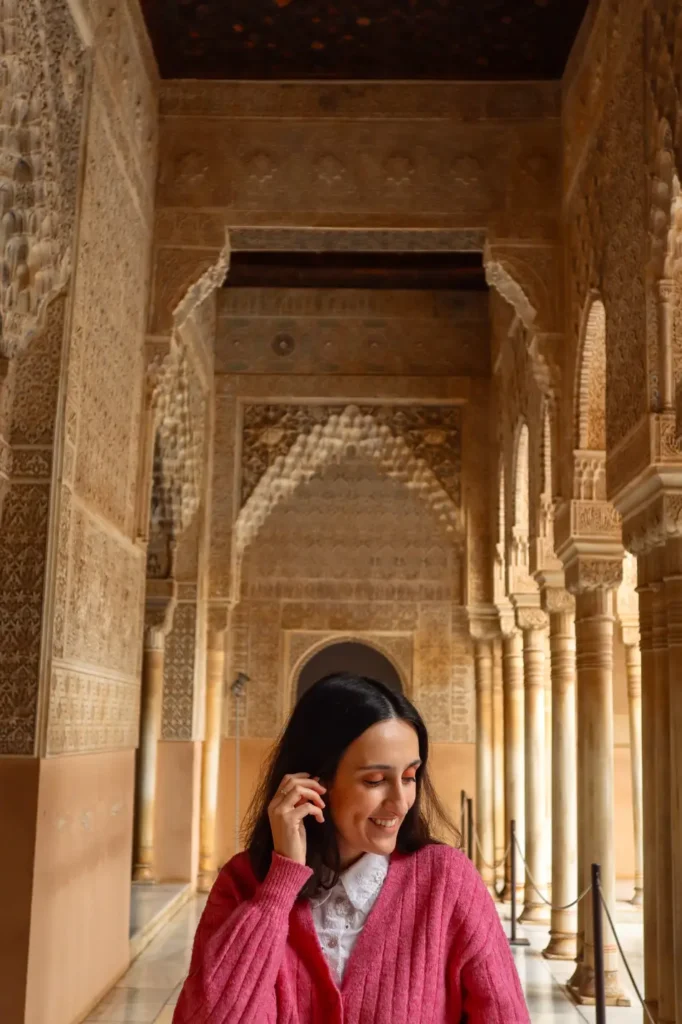
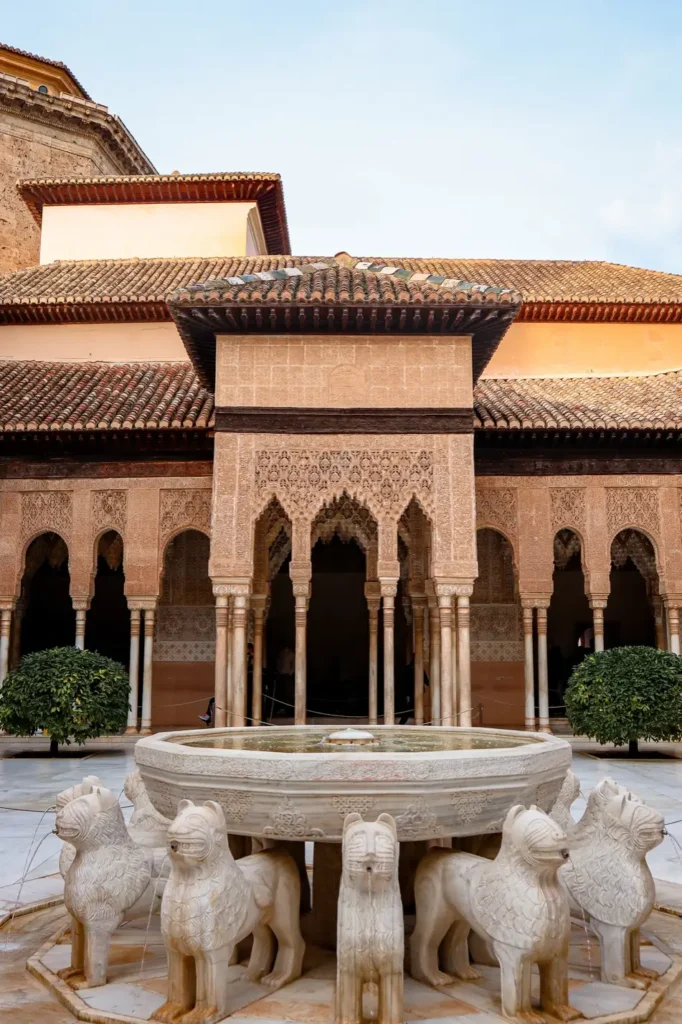
Since entry is regulated by timed slots, it’s essential to plan your visit carefully. Starting your day here allows you to take in the beauty of the palaces without the rush, leaving time to explore the rest of the Alhambra complex at your leisure.
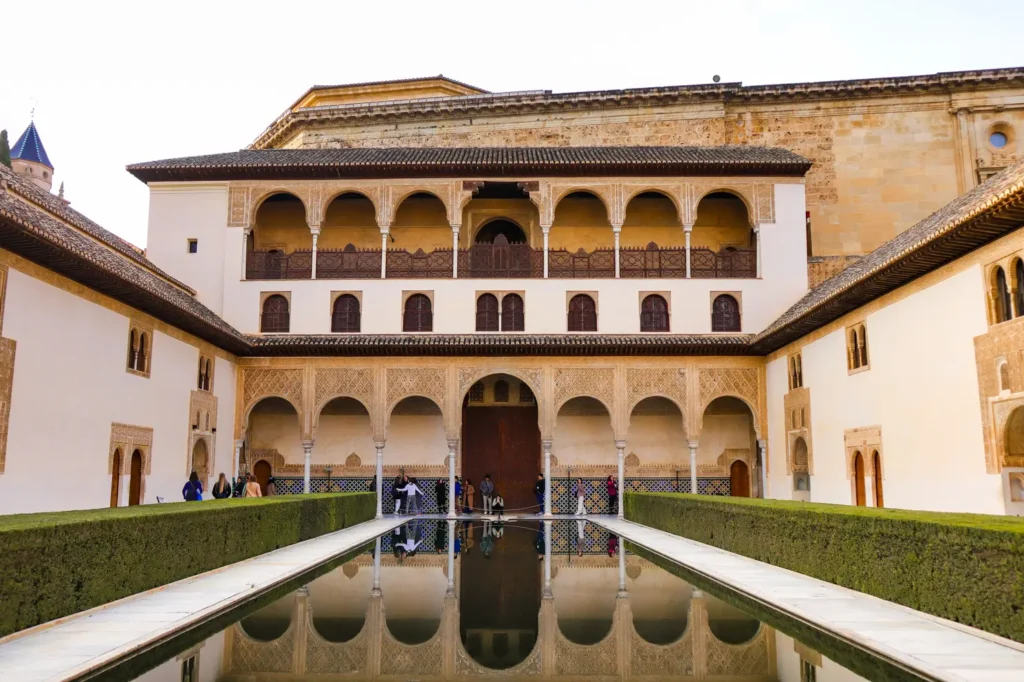
Don’t expect to have the place to yourself! Taking photos without other people in the frame is nearly impossible. I visited on a Sunday morning in December at 9 am (it opens at 8.30 am during this time of year), and it was already bustling with visitors! But it’s so pretty, that you’ll forget everything else.
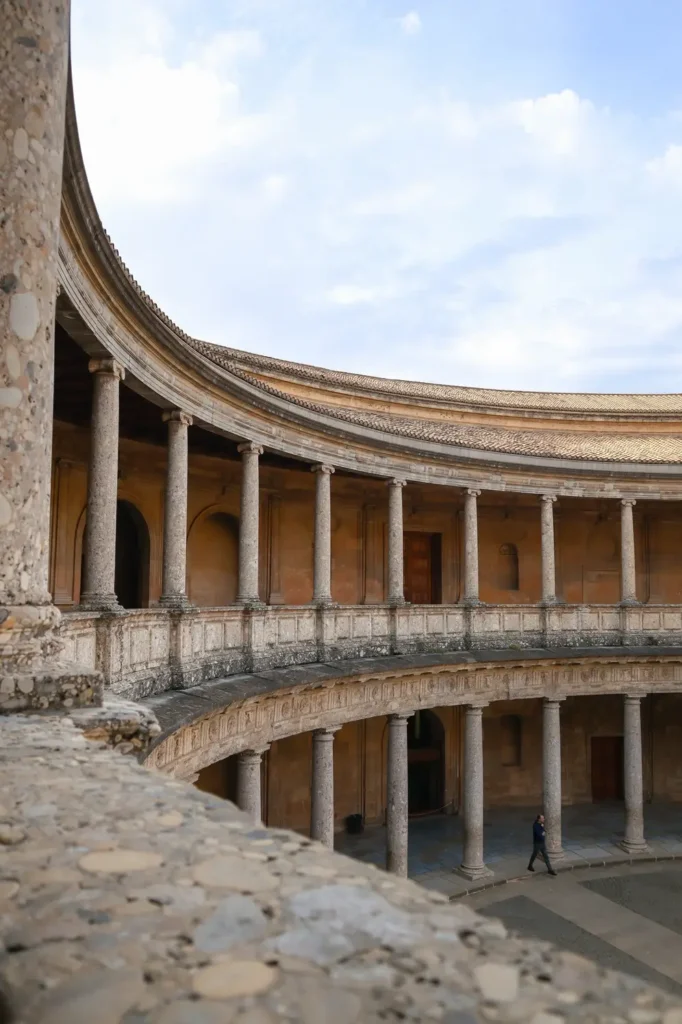
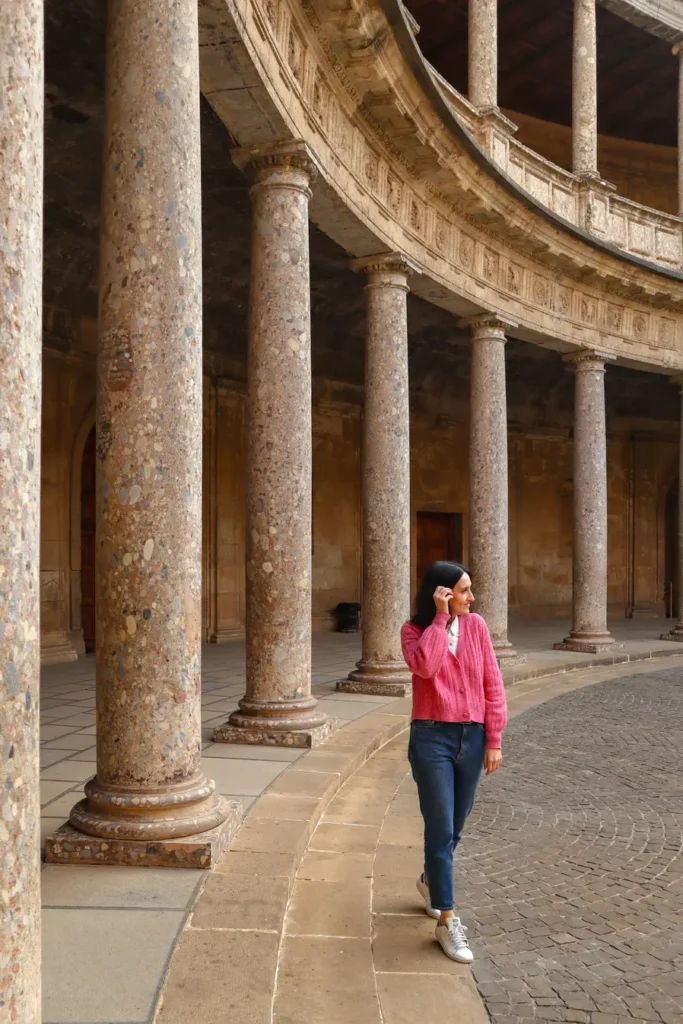
💡 EXTRA TIP: Also visit Charles V Palace which is near the Nasrid Palaces. It was commissioned by Emperor Charles V in the 16th century. It features a unique circular courtyard surrounded by imposing columns. Inside, you can also visit two museums. However, if you’re planning to spend only half a day in Alhambra, you won’t have time to visit them.
» Alcazaba
The Alcazaba is the oldest part of the Alhambra and served as a military fortress during the Nasrid dynasty. It offers panoramic views of Granada and the surrounding landscapes. The fortress’s strategic location highlights its importance in defending the city during medieval times.
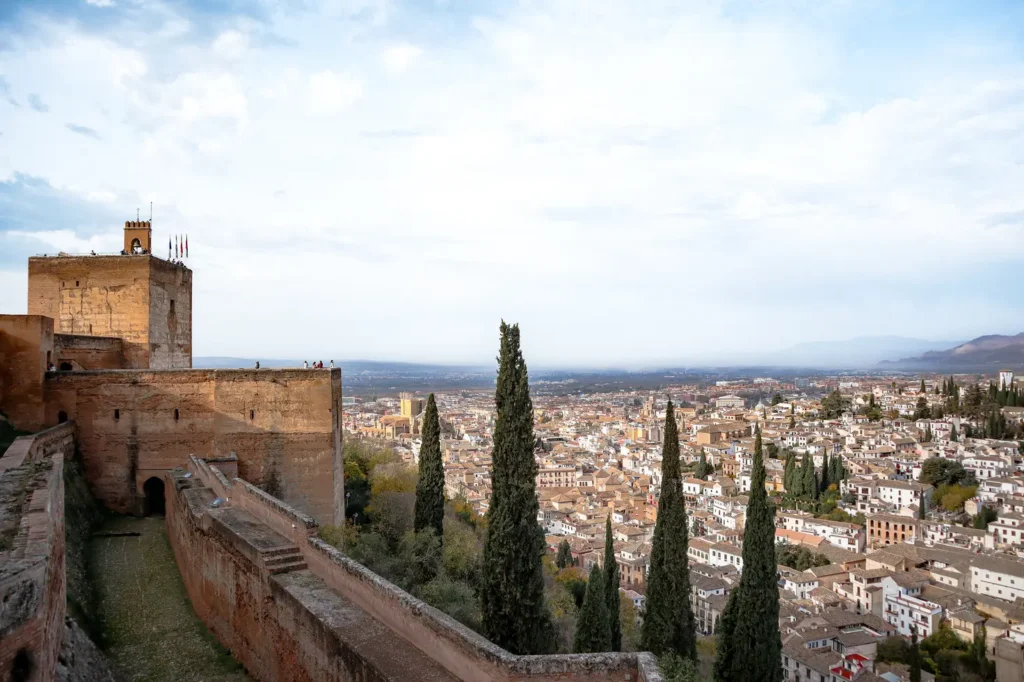
Much of the interior is in ruins. Yet, visitors can still explore its towers and walls, including the Torre de la Vela, the highest point of the Alcazaba. Climbing the tower is well worth the effort, as it provides some of the best views of the city and the Sierra Nevada mountains.
» Generalife Gardens
End your visit to the Alhambra at Generalife Gardens. Originally the summer palace for the Nasrid rulers, the Generalife was designed as a retreat from the hustle and bustle of court life.
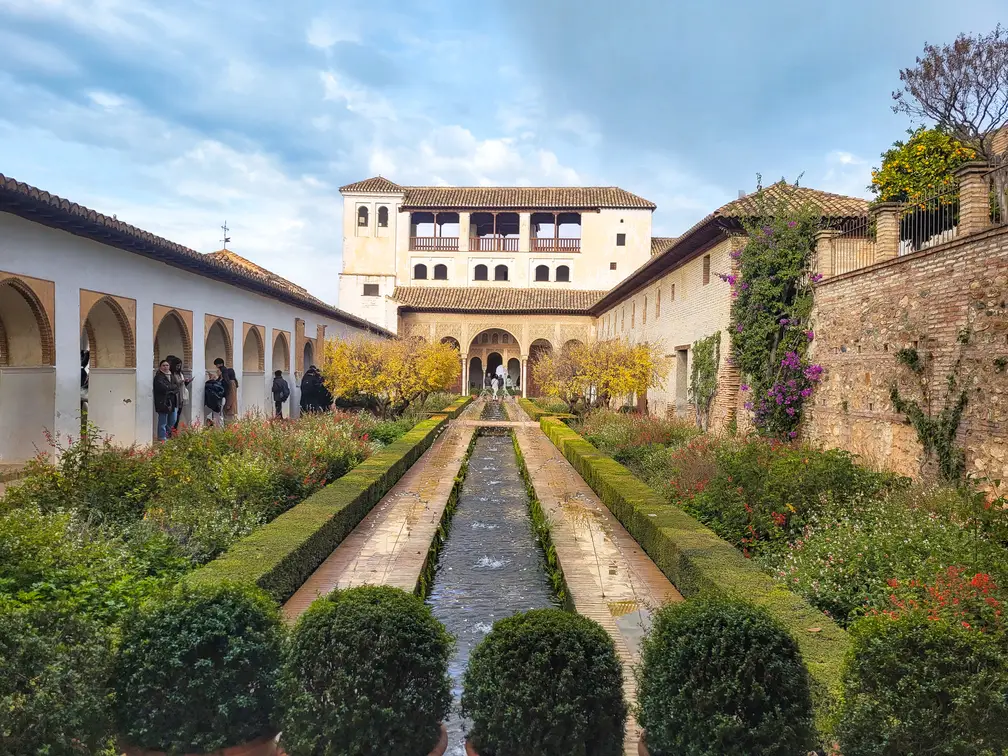
Highlights include the Patio de la Acequia, with its iconic long reflecting pool framed by vibrant flowers and arches. Admire also the upper terraces, which provide breathtaking views of Granada and the surrounding mountains.
The Generalife’s simplicity and elegance stand in contrast to the ornate Nasrid Palaces. It offers a unique perspective on the lifestyle of Granada’s former rulers.
Day 2 in Granada: Afternoon
» Paseo de los Tristes
After finishing your visit to Alhambra, head down to the city centre and visit Paseo de los Tristes.
Nestled along the Darro River at the foot of the Alhambra, this scenic promenade offers stunning views of the Alhambra’s towering walls and lush surroundings.
Its name, meaning “Promenade of the Sad Ones,” originates from the funeral processions that once passed through here on their way to the cemetery.
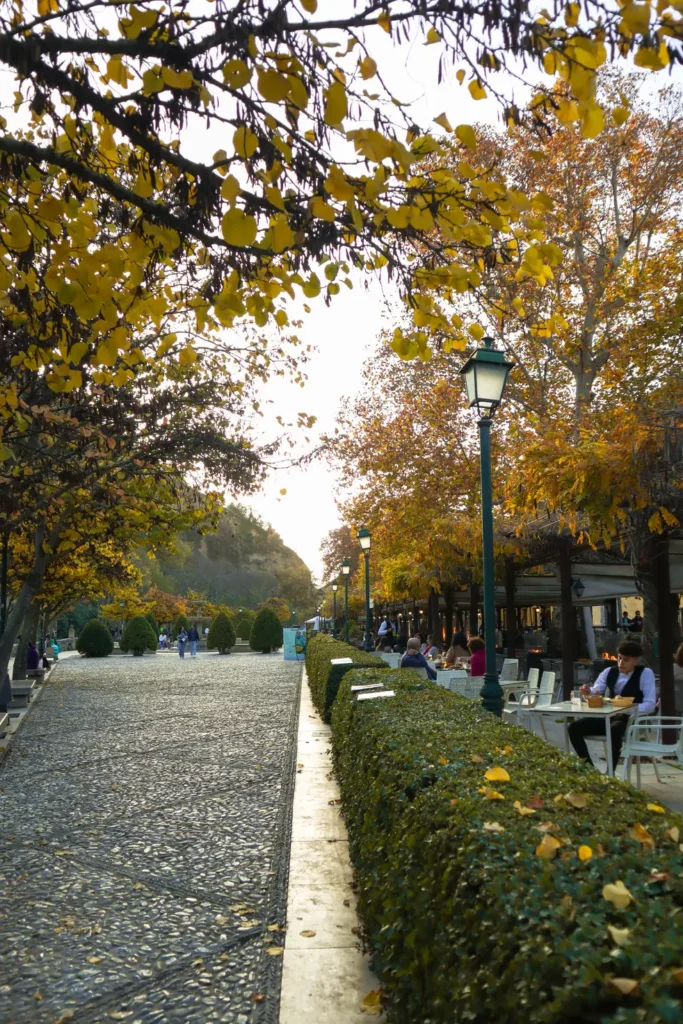
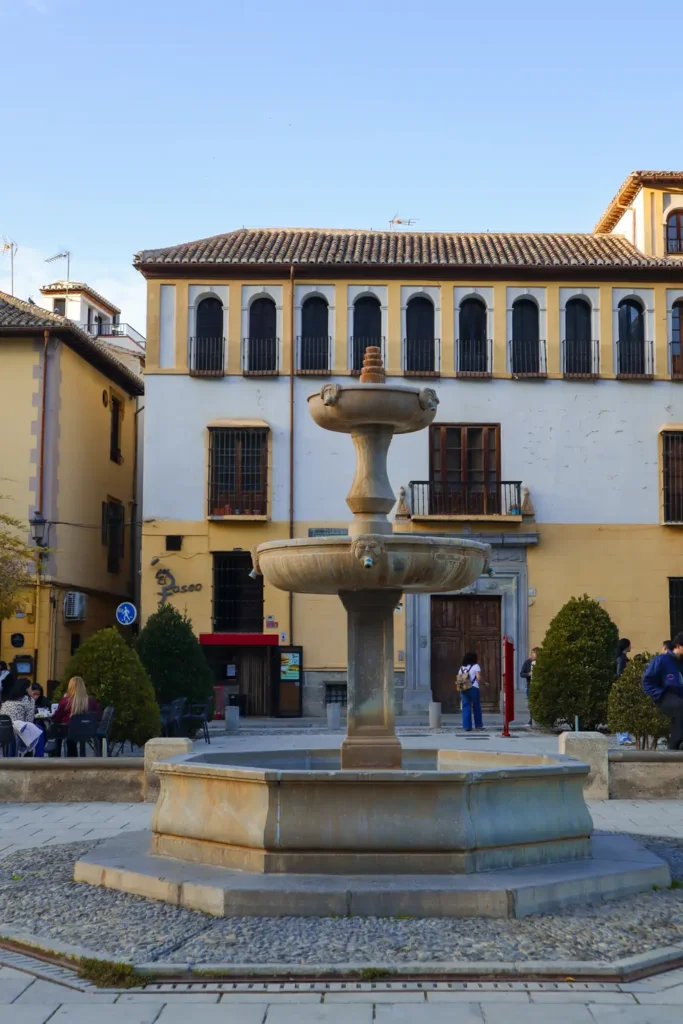
Lined with charming cafés, restaurants, and historic buildings, Paseo de los Tristes is a lively spot perfect for a relaxing stroll or a meal with a view.
» Carrera del Darro
Continue walking towards Carrera del Darro. Flanked by ancient stone bridges, this cobblestone street is often considered one of the most beautiful in the city.
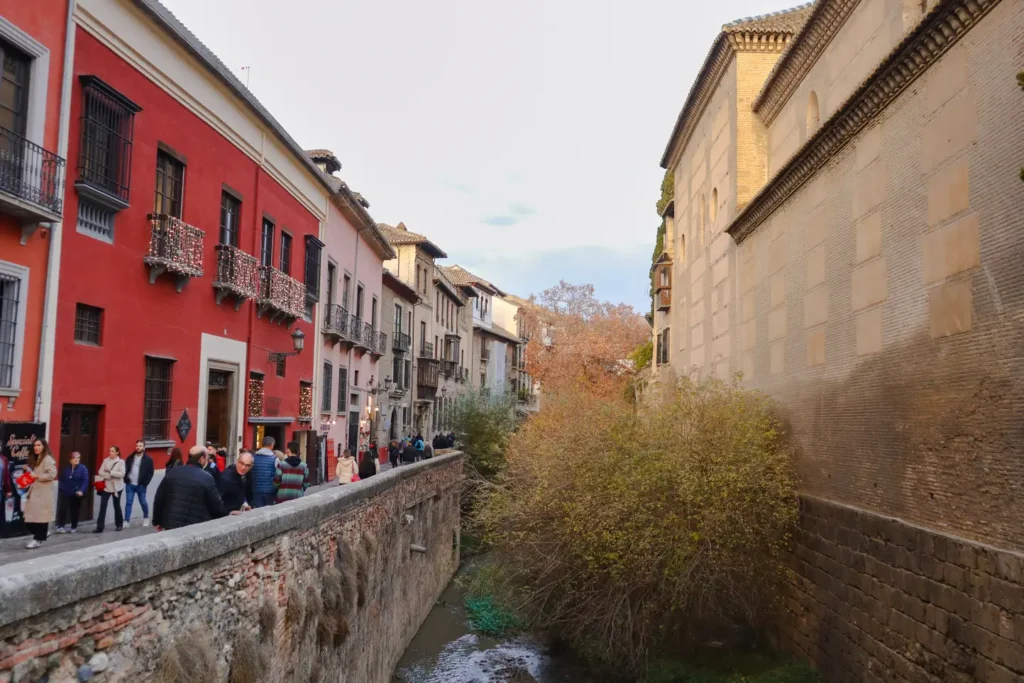
As you walk along the Carrera del Darro, you’ll pass historic landmarks. These include the 11th-century Arab Baths (Baños Árabes) and Casa de Zafra, now a museum showcasing Moorish architecture. The street is also lined with quaint cafés and artisan shops, perfect for taking a break.
» El Bañuelo
On your stroll at Carrera del Darro, stop at El Bañuelo. This is one of the best-preserved Arab baths in Spain and a fascinating glimpse into Granada’s Moorish history.
Built in the 11th century, these ancient baths were an important social and cultural hub. They were used for relaxation, hygiene, and religious purification.
Inside, you’ll find beautiful star-shaped skylights in the domed ceilings. These allowed natural light to fill the rooms while providing ventilation. The different chambers—cold, warm, and hot—give visitors an idea of how these baths functioned in daily life.
📝 USEFUL INFORMATION: The opening hours of El Bañuelo depend on the time of year. Check out the most updated info about El Bañuelo.
» Elvira Gate
Also, include Elvira Gate (Puerta de Elvira) on your 2-day Granada itinerary. This is a historic gateway that once served as the main entrance to Granada’s walled city during the Nasrid period.
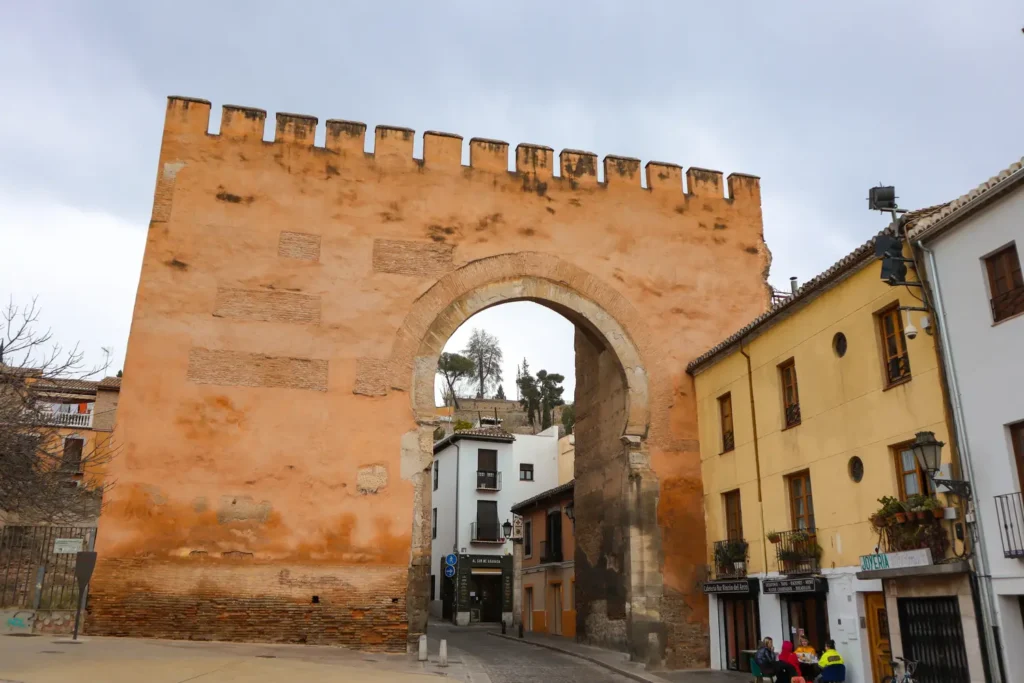
Dating back to the 9th century, this impressive structure marked the beginning of the road to the city of Almería. Plus, it was an important defensive feature.
Though parts of the original wall are no longer standing, the Elvira Gate remains a symbol of Granada’s medieval past.
» San Juan de Dios Basilica
This Granada itinerary might be ending but there are still some surprises left!
The Basilica of San Juan de Dios is a Baroque masterpiece in Granada, dedicated to Saint John of God, the patron saint of hospitals and the sick.
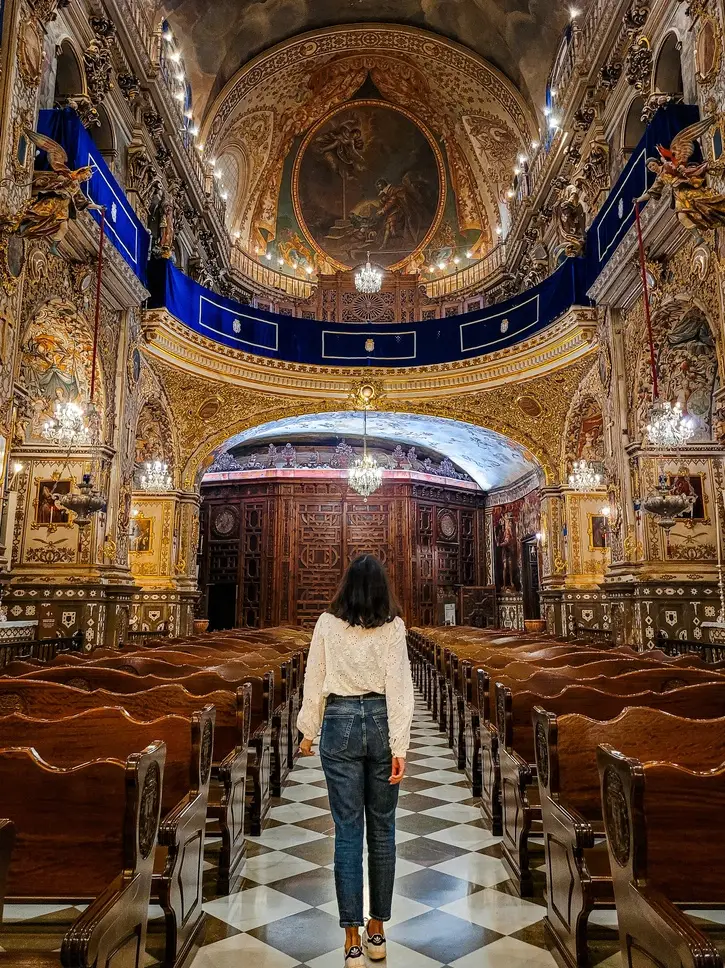
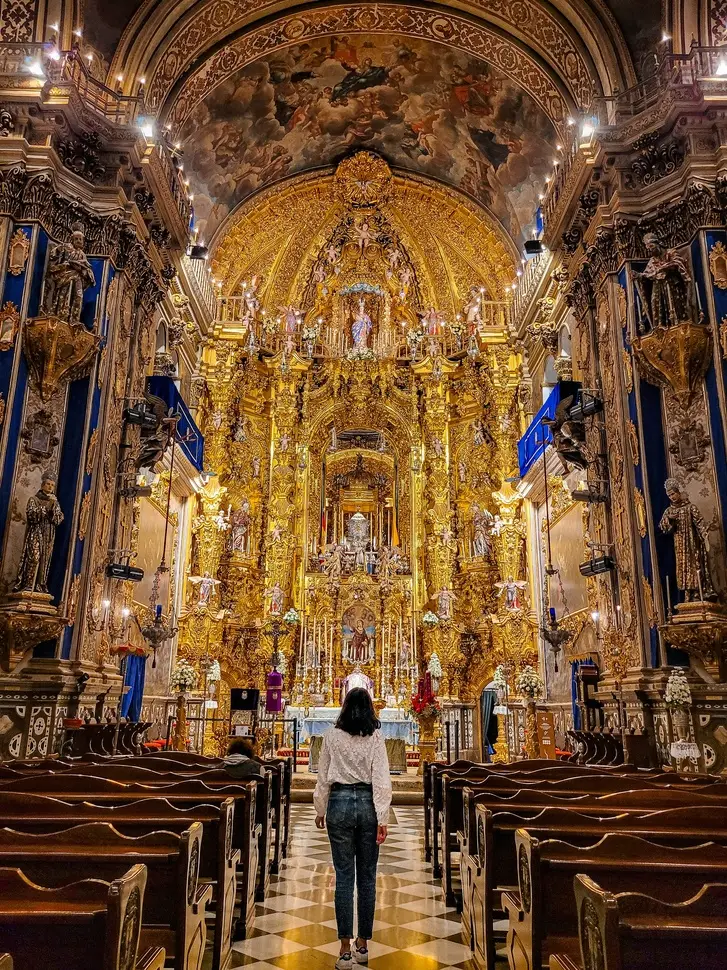
Built in the 18th century, the basilica’s ornate interior is a feast for the eyes. It features gilded altars, intricate frescoes, and elaborate carvings that showcase the grandeur of Baroque architecture.
One of its most striking features is the main altar, which houses the silver-plated reliquary containing the remains of Saint John of God. The basilica’s soaring ceilings and radiant decoration make it one of the most beautiful religious sites in the city. And it’s not that touristy at all!
📝 USEFUL INFORMATION: The basilica costs 10€ to visit (the combined ticket won’t work here) and you get a comprehensive audio guide. Find all the details about Basilica San Juan de Dios.
» La Cartuja Monastery
End your 2 days in Granada in another yet magnificent church – Cartuja Monastery.
Monasterio de la Cartuja is another stunning example of Baroque architecture, located just outside Granada’s city centre. It is known for its richly decorated interiors, which contrast with its simple exterior.
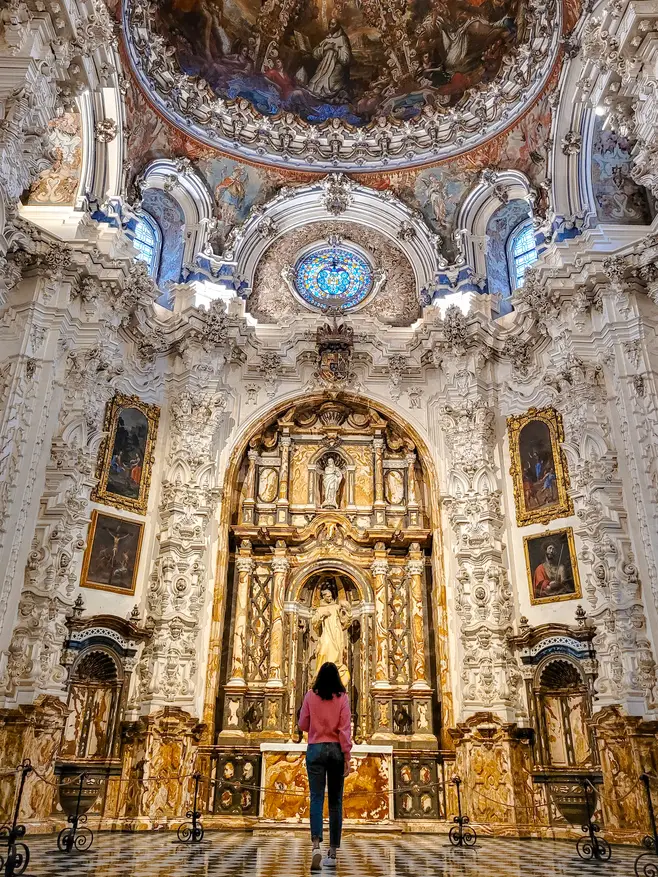
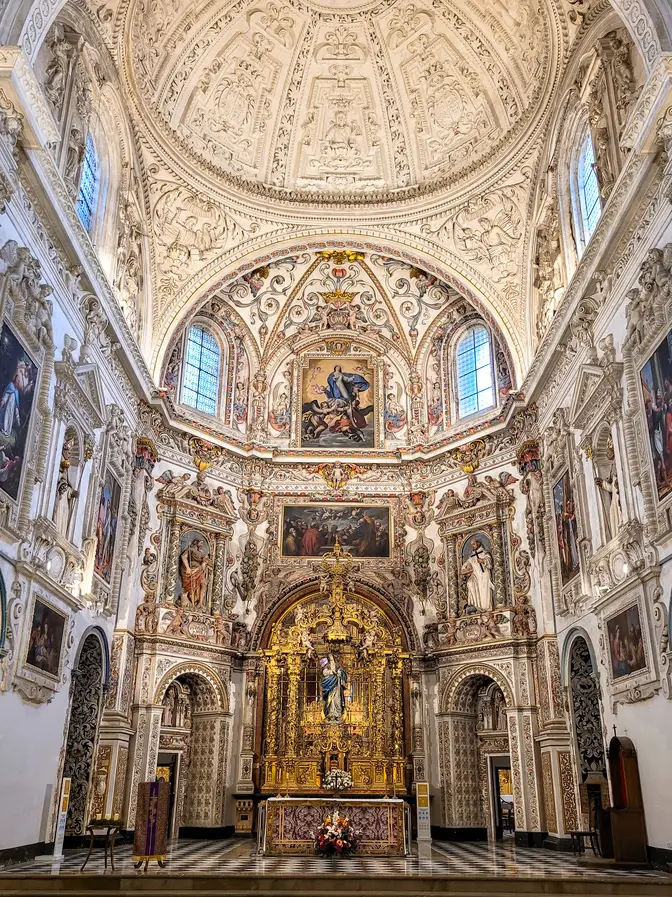
The monastery also features a tranquil cloister and small chapels, offering a glimpse into the quiet life of the monks.
📝 USEFUL INFORMATION: The Cartuja monastery is open from Sundays to Fridays from 10 am to 6.30 pm and on Saturdays from 10 am to 12.30 pm and from 3 pm to 5.30 pm. Tickets cost 6€ but you can use the combined ticket here. Check updated info about Cartuja monastery.
Alternative Granada 1-day Itinerary
If you’re short on time, here’s an alternative 1-day itinerary in Granada that covers the essentials:
- Morning: Start your day at the Alhambra. Visit the Nasrid Palaces, Alcazaba, and Generalife Gardens to experience Granada’s most iconic landmark.
- Lunch: Enjoy a traditional Andalusian meal at a nearby restaurant, like Los Manueles or Bodegas Castañeda, to recharge for the afternoon.
- Afternoon: Begin your exploration at the Carrera del Darro, one of Granada’s most charming streets. Then head to Calle Calderería Nueva and La Alcaicería, where the Moorish influence comes alive. If time allows it, visit the Granada Cathedral, one of the most important religious temples in the city.
- Evening: Have fun watching a flamenco show
This itinerary ensures you experience Granada’s highlights, even with limited time!
How to get to Granada?
Granada is well-connected and easy to reach, whether you’re travelling from within Spain or abroad. Here are the main options:
- By Plane: Granada-Jaén Airport (GRX) is the closest airport, with domestic and some international flights. Alternatively, you can fly to Málaga Airport (AGP), which offers more options and is about 1.5 hours away by car or bus.
- By Train: High-speed trains (AVE) connect Granada to major cities like Madrid and Seville. The journey is comfortable and a great way to enjoy Spain’s scenic landscapes.
- By Bus: Buses are an affordable option, with frequent routes from cities like Málaga, Seville, and Córdoba. The main bus station is just a short taxi ride from the city centre.
- By Car: Driving to Granada gives you the freedom to explore at your own pace. The city is well-connected by motorways, but parking in the city centre can be tricky.
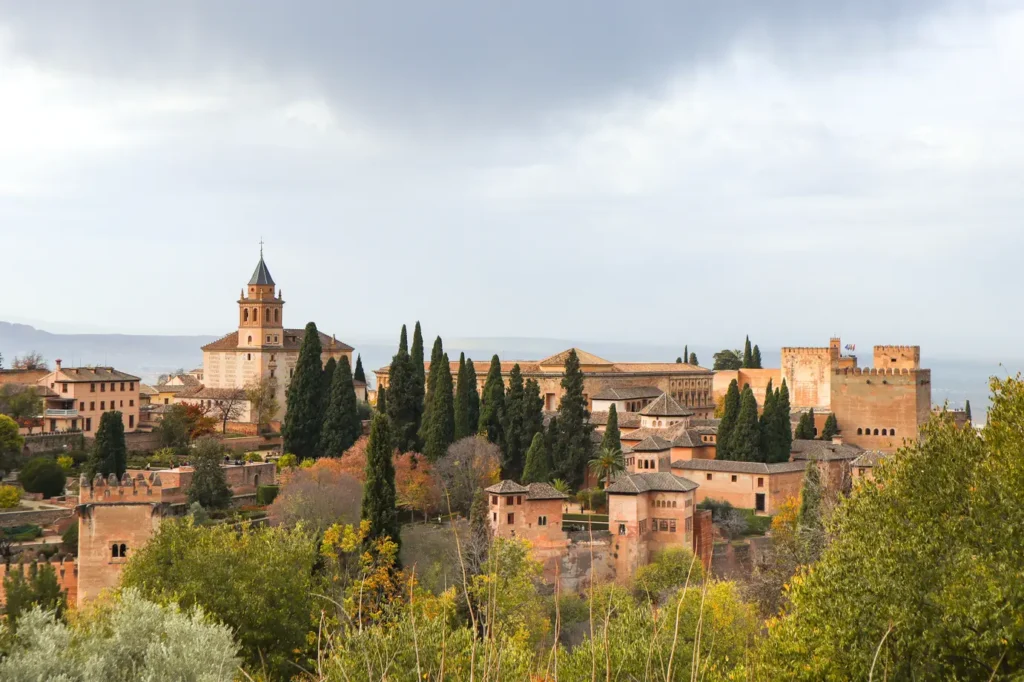
I flew from Portugal to Málaga and rented a car through Discover Cars and drove to Granada, even though I didn’t use the car much while exploring Granada. If you’re planning a road trip through Andalusia, renting a car is definitely the best way to make the most of your journey.
Keep in mind that you likely won’t need a car to explore Granada, as most attractions are easily accessible on foot or by public transport. To avoid parking hassles, opt for accommodation that includes parking facilities.
Must-try restaurants in Granada
Granada’s food scene is as vibrant as its history, offering a mix of traditional Andalusian flavours and unique local dishes. Here are three must-visit restaurants to add to your itinerary:
- Bodegas Castañeda (€): A local institution, Bodegas Castañeda is the perfect spot to experience Granada’s iconic tapas culture. Known for its rustic charm and lively atmosphere, there are several across town. Order the tabla caliente to try out many different things on the menu.
- Los Manueles (€): a Granada classic, offering a menu filled with traditional Andalusian dishes. Their famous croquettes are a must-try, and the welcoming atmosphere makes it a great choice for both lunch and dinner. This was my favourite in Granada.
- La Bodega de Antonio (€): even though this wasn’t my favourite, the portions are big and cheap. Plus, I think we were the only tourists there and people were already queuing before opening time.

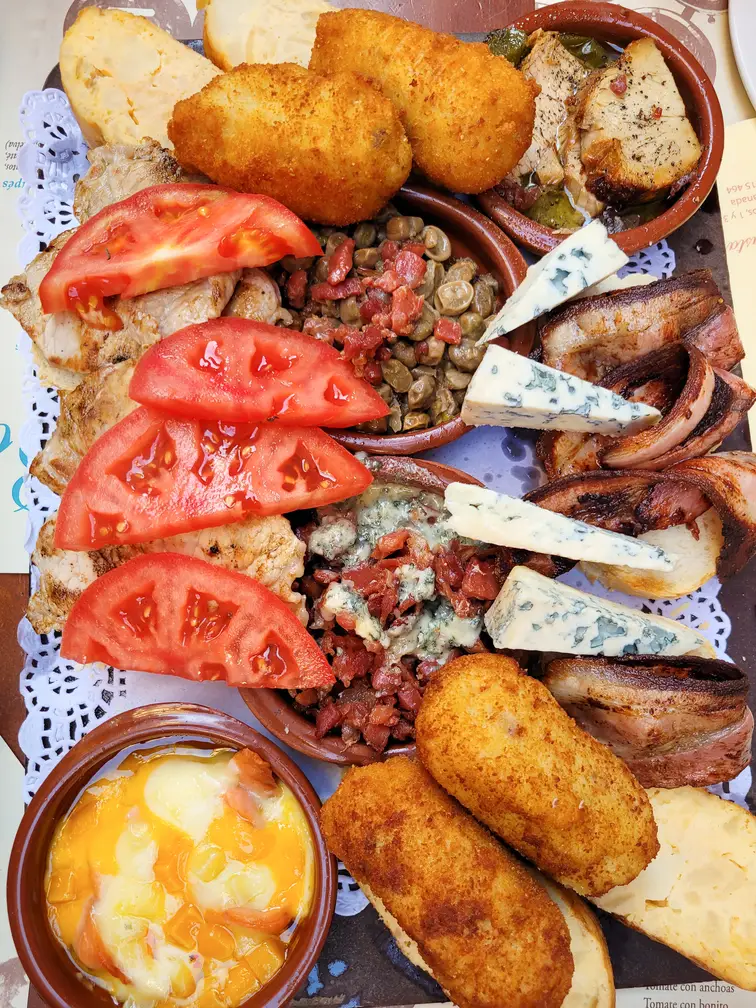
What is the best time to visit Granada?
The best time to visit Granada is in spring (March to May) or autumn (September to November). During these months, the weather is mild. It’s perfect for exploring the Alhambra and strolling through the city’s historic neighbourhoods.
For example, I visited in early December, and while the weather was chilly, the sunshine added a touch of warmth that made my visit more enjoyable.
Summer can be very hot, especially in July and August, while winter is quieter but chilly, with fewer crowds. Choose spring or autumn for the most comfortable experience and vibrant local events.
What to pack for Granada?
When visiting Granada, pack comfortable walking shoes for exploring its cobbled streets and hilly areas, especially in the Albaicín. Layers are essential, as mornings and evenings can be cooler, even in warmer months. Don’t forget sunscreen and a hat for protection during sunny days.
In winter, bring a warm coat and scarf, as temperatures can drop significantly. For summer visits, light, breathable clothing is a must.
If you’re planning to visit the Alhambra, carry a reusable water bottle and snacks to stay refreshed while exploring the vast complex.
How to get around Granada?
Granada is a compact and walkable city, making it easy to explore most attractions on foot. The historic areas, like the Albaicín, are best experienced by strolling through their narrow, cobbled streets.
For longer distances or trips uphill, such as to the Alhambra, public buses are a convenient option. The city has a reliable bus network, and routes like the C30 and C32 connect key sites. Tickets are quite inexpensive (about 1.6€ one way).
Taxis and ride-hailing apps are also readily available for quick trips around the city.
Do I need to book Alhambra tickets in advance?
Yes, it’s highly recommended to book your Alhambra tickets in advance. The Alhambra is one of the most visited attractions in Spain.
Tickets often sell out weeks ahead, especially during peak travel seasons. Booking early ensures you get the time slot you prefer and avoid disappointment. You can book as early as 3 months in advance.
Tickets can be reserved online through the official Alhambra website. Don’t forget to bring your ID because they ask for it several times!
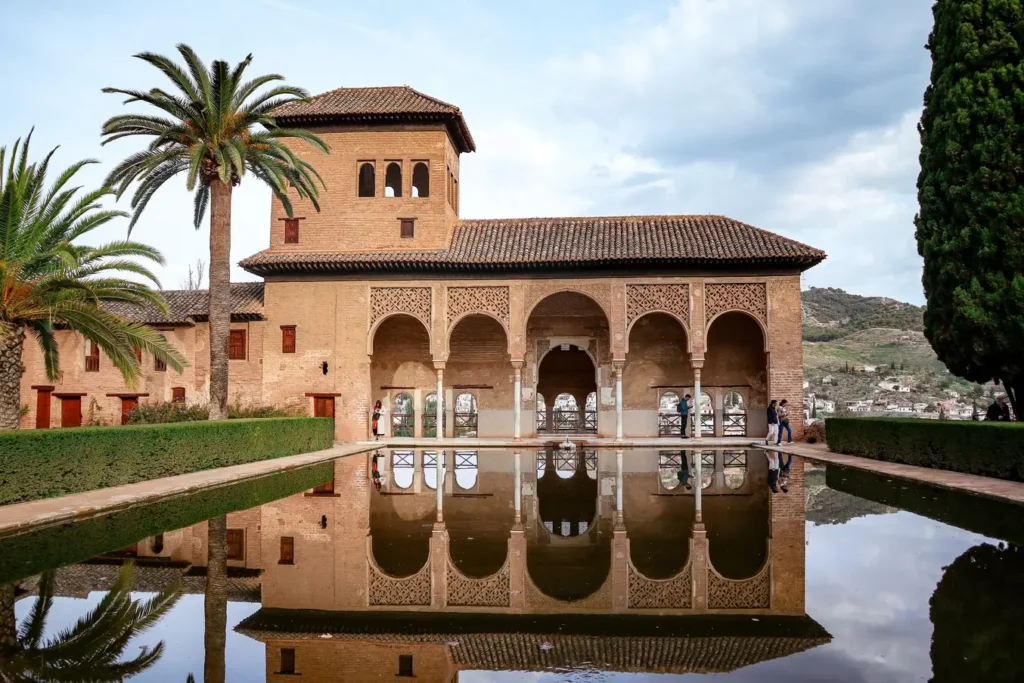
Final Thoughts on Granada
Spending 2 days in Granada is the perfect way to experience the magic of this enchanting city. From the awe-inspiring Alhambra to the winding streets of the Albaicín, every corner of Granada is filled with history, culture, and unforgettable views.
This Granada itinerary ensures you’ll make the most of your time, balancing iconic landmarks with authentic local experiences.
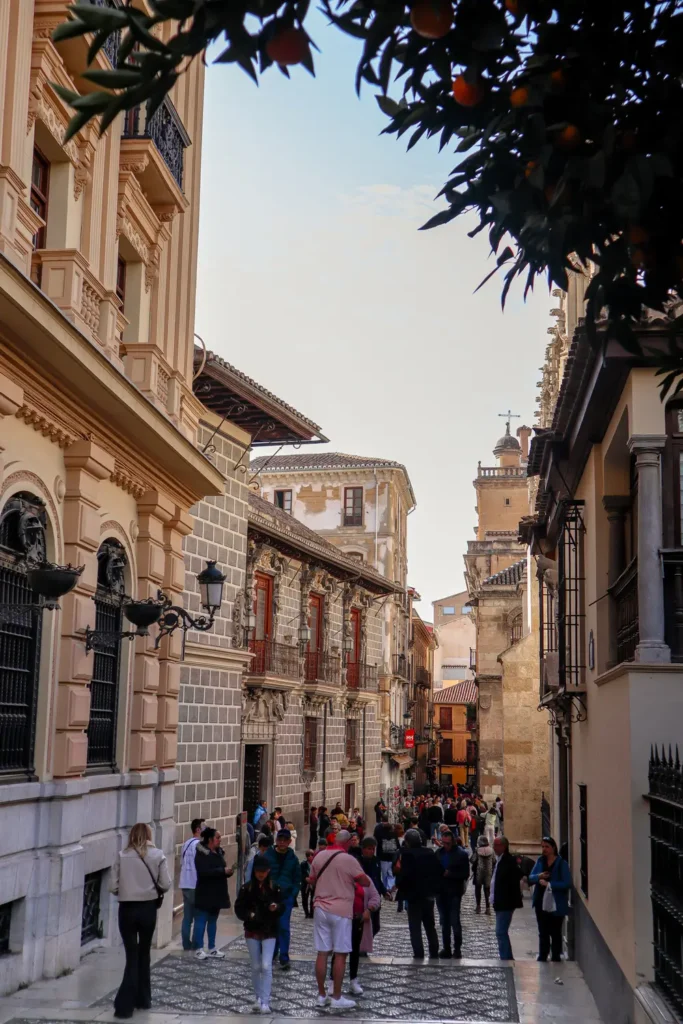
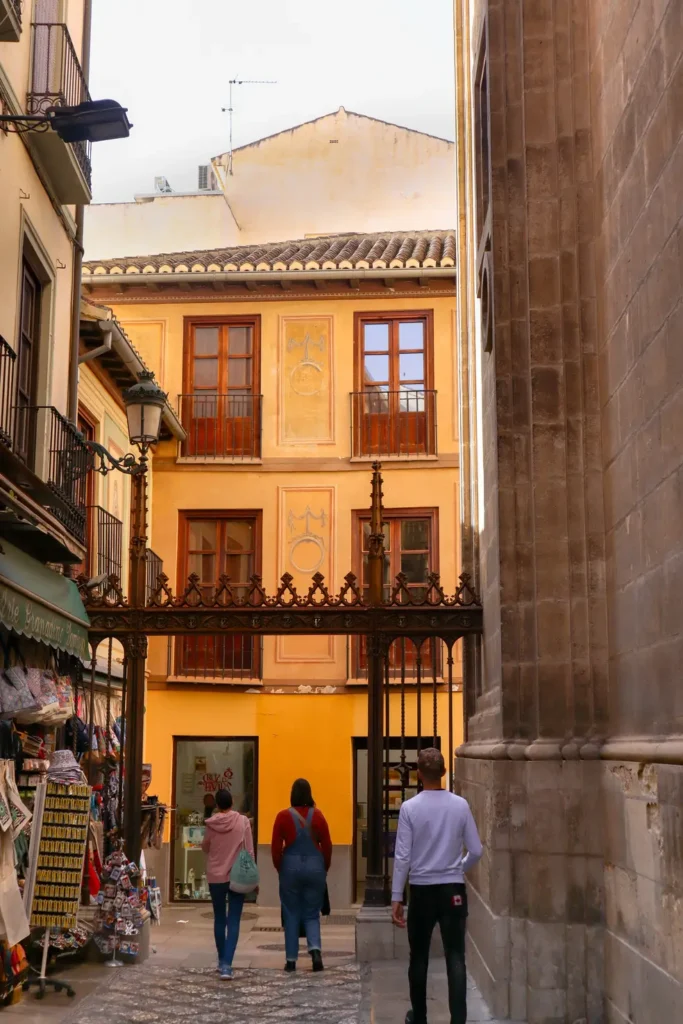
Now it’s your turn—have you been to Granada? Or are you planning your trip? I’d love to hear your thoughts, tips, or questions about Granada in the comments below.
If you’re planning an Andalusia road trip, don’t miss my 8-day Andalusia itinerary packed with the best experiences in the region.
Happy travels and enjoy your time in this incredible city! 😊
Disclaimer: this post may contain some affiliate links, which means I get a small commission if you buy something through my links. This doesn’t represent any additional cost to you and you’ll be supporting my work here on the blog😊

